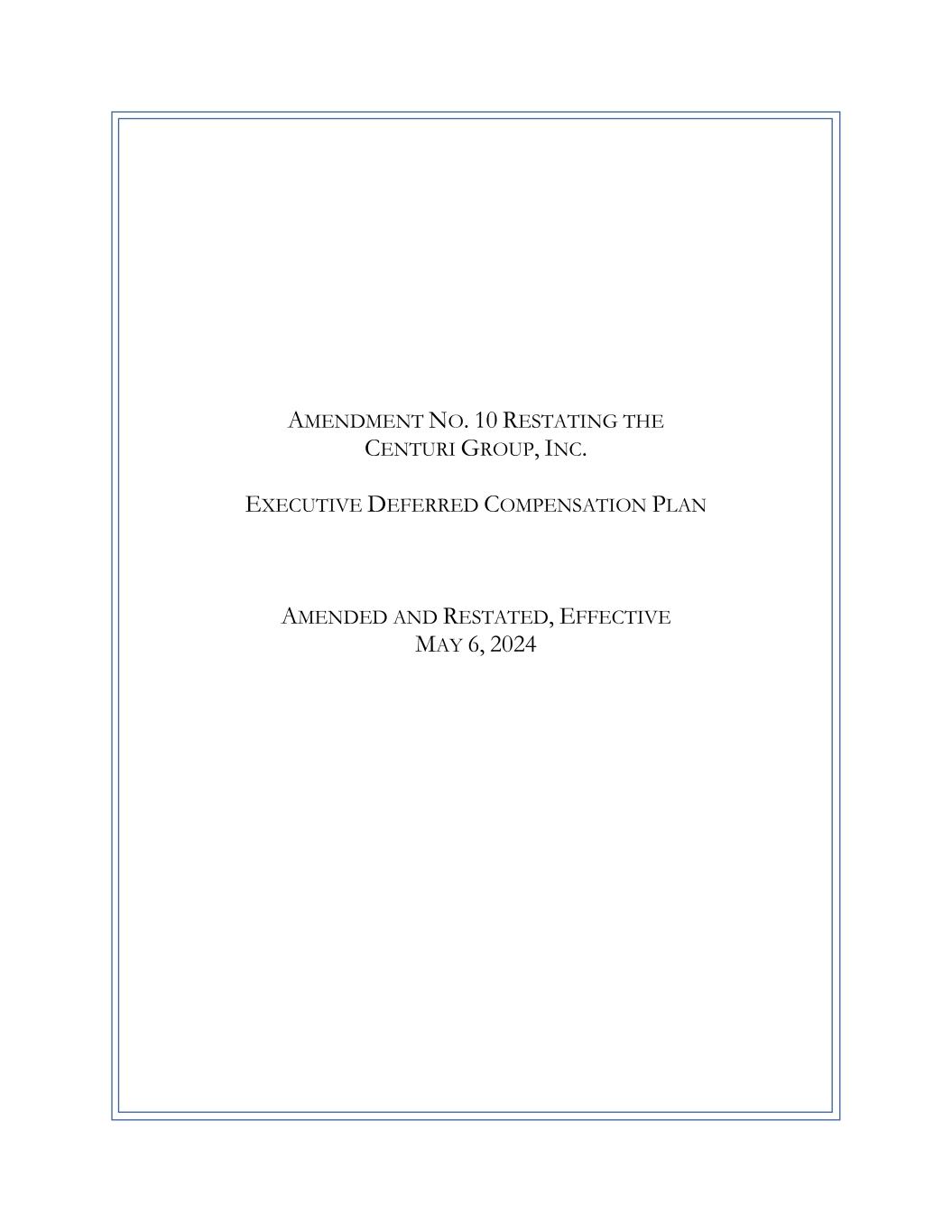
AMENDMENT NO. 10 RESTATING THE CENTURI GROUP, INC. EXECUTIVE DEFERRED COMPENSATION PLAN AMENDED AND RESTATED, EFFECTIVE MAY 6, 2024
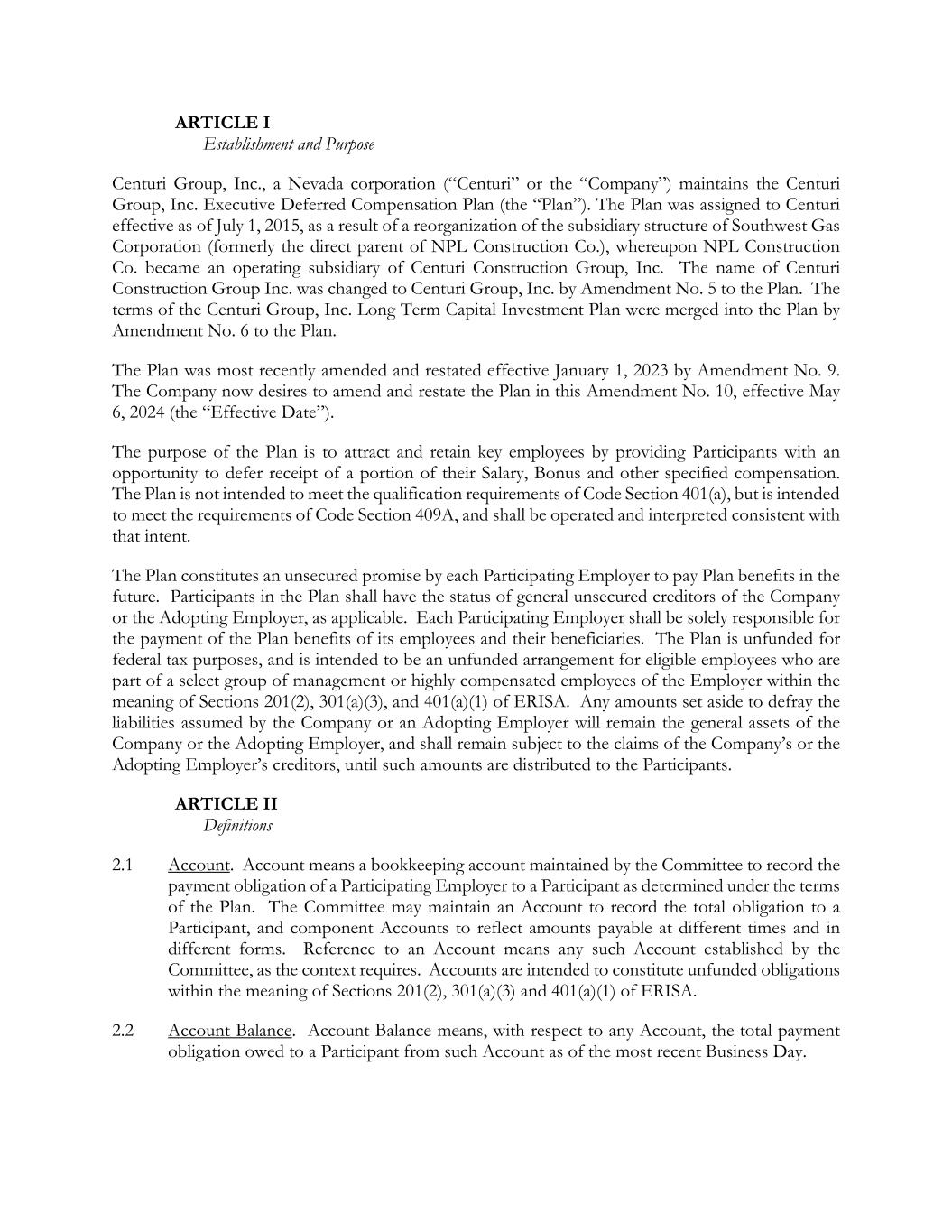
ARTICLE I Establishment and Purpose Centuri Group, Inc., a Nevada corporation (“Centuri” or the “Company”) maintains the Centuri Group, Inc. Executive Deferred Compensation Plan (the “Plan”). The Plan was assigned to Centuri effective as of July 1, 2015, as a result of a reorganization of the subsidiary structure of Southwest Gas Corporation (formerly the direct parent of NPL Construction Co.), whereupon NPL Construction Co. became an operating subsidiary of Centuri Construction Group, Inc. The name of Centuri Construction Group Inc. was changed to Centuri Group, Inc. by Amendment No. 5 to the Plan. The terms of the Centuri Group, Inc. Long Term Capital Investment Plan were merged into the Plan by Amendment No. 6 to the Plan. The Plan was most recently amended and restated effective January 1, 2023 by Amendment No. 9. The Company now desires to amend and restate the Plan in this Amendment No. 10, effective May 6, 2024 (the “Effective Date”). The purpose of the Plan is to attract and retain key employees by providing Participants with an opportunity to defer receipt of a portion of their Salary, Bonus and other specified compensation. The Plan is not intended to meet the qualification requirements of Code Section 401(a), but is intended to meet the requirements of Code Section 409A, and shall be operated and interpreted consistent with that intent. The Plan constitutes an unsecured promise by each Participating Employer to pay Plan benefits in the future. Participants in the Plan shall have the status of general unsecured creditors of the Company or the Adopting Employer, as applicable. Each Participating Employer shall be solely responsible for the payment of the Plan benefits of its employees and their beneficiaries. The Plan is unfunded for federal tax purposes, and is intended to be an unfunded arrangement for eligible employees who are part of a select group of management or highly compensated employees of the Employer within the meaning of Sections 201(2), 301(a)(3), and 401(a)(1) of ERISA. Any amounts set aside to defray the liabilities assumed by the Company or an Adopting Employer will remain the general assets of the Company or the Adopting Employer, and shall remain subject to the claims of the Company’s or the Adopting Employer’s creditors, until such amounts are distributed to the Participants. ARTICLE II Definitions 2.1 Account. Account means a bookkeeping account maintained by the Committee to record the payment obligation of a Participating Employer to a Participant as determined under the terms of the Plan. The Committee may maintain an Account to record the total obligation to a Participant, and component Accounts to reflect amounts payable at different times and in different forms. Reference to an Account means any such Account established by the Committee, as the context requires. Accounts are intended to constitute unfunded obligations within the meaning of Sections 201(2), 301(a)(3) and 401(a)(1) of ERISA. 2.2 Account Balance. Account Balance means, with respect to any Account, the total payment obligation owed to a Participant from such Account as of the most recent Business Day.
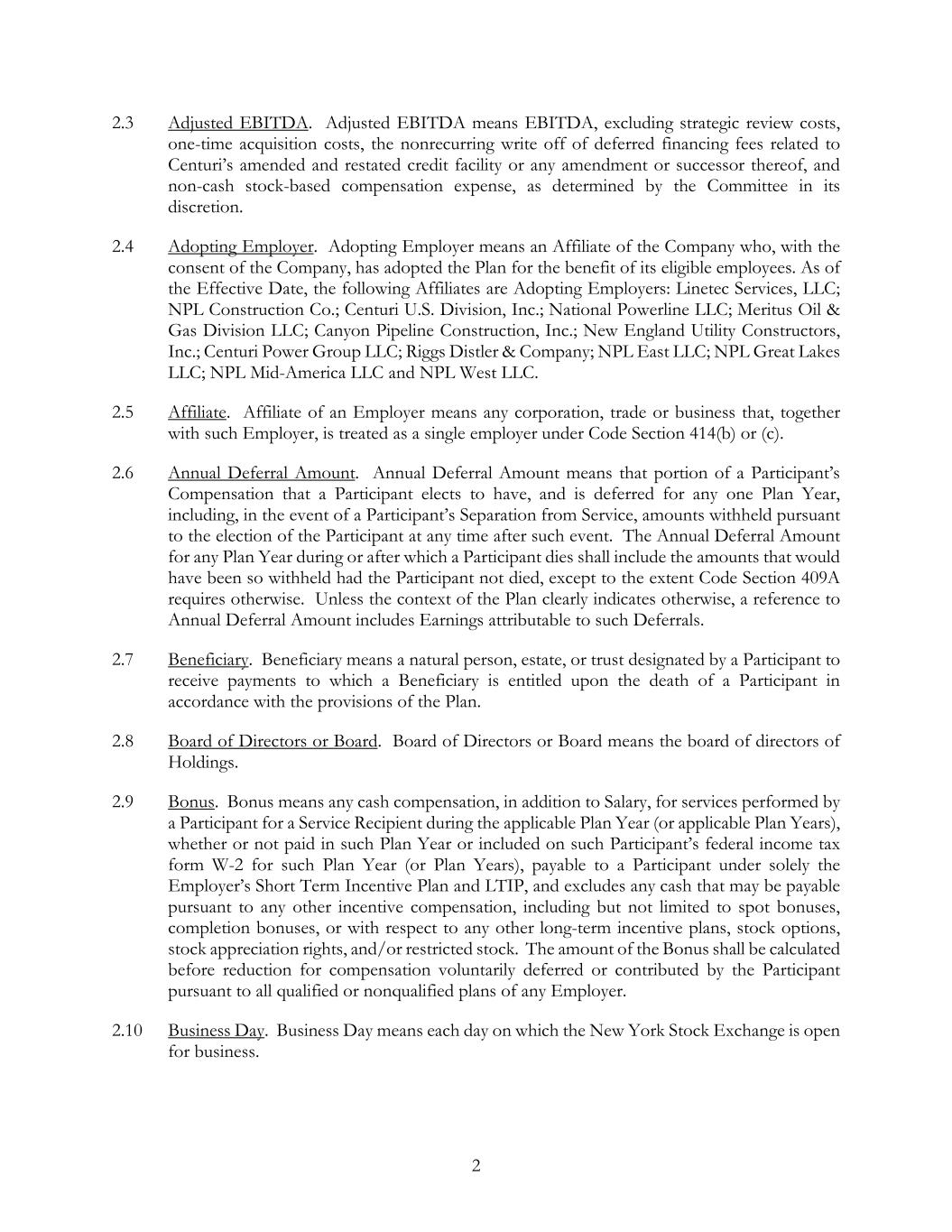
2 2.3 Adjusted EBITDA. Adjusted EBITDA means EBITDA, excluding strategic review costs, one-time acquisition costs, the nonrecurring write off of deferred financing fees related to Centuri’s amended and restated credit facility or any amendment or successor thereof, and non-cash stock-based compensation expense, as determined by the Committee in its discretion. 2.4 Adopting Employer. Adopting Employer means an Affiliate of the Company who, with the consent of the Company, has adopted the Plan for the benefit of its eligible employees. As of the Effective Date, the following Affiliates are Adopting Employers: Linetec Services, LLC; NPL Construction Co.; Centuri U.S. Division, Inc.; National Powerline LLC; Meritus Oil & Gas Division LLC; Canyon Pipeline Construction, Inc.; New England Utility Constructors, Inc.; Centuri Power Group LLC; Riggs Distler & Company; NPL East LLC; NPL Great Lakes LLC; NPL Mid-America LLC and NPL West LLC. 2.5 Affiliate. Affiliate of an Employer means any corporation, trade or business that, together with such Employer, is treated as a single employer under Code Section 414(b) or (c). 2.6 Annual Deferral Amount. Annual Deferral Amount means that portion of a Participant’s Compensation that a Participant elects to have, and is deferred for any one Plan Year, including, in the event of a Participant’s Separation from Service, amounts withheld pursuant to the election of the Participant at any time after such event. The Annual Deferral Amount for any Plan Year during or after which a Participant dies shall include the amounts that would have been so withheld had the Participant not died, except to the extent Code Section 409A requires otherwise. Unless the context of the Plan clearly indicates otherwise, a reference to Annual Deferral Amount includes Earnings attributable to such Deferrals. 2.7 Beneficiary. Beneficiary means a natural person, estate, or trust designated by a Participant to receive payments to which a Beneficiary is entitled upon the death of a Participant in accordance with the provisions of the Plan. 2.8 Board of Directors or Board. Board of Directors or Board means the board of directors of Holdings. 2.9 Bonus. Bonus means any cash compensation, in addition to Salary, for services performed by a Participant for a Service Recipient during the applicable Plan Year (or applicable Plan Years), whether or not paid in such Plan Year or included on such Participant’s federal income tax form W-2 for such Plan Year (or Plan Years), payable to a Participant under solely the Employer’s Short Term Incentive Plan and LTIP, and excludes any cash that may be payable pursuant to any other incentive compensation, including but not limited to spot bonuses, completion bonuses, or with respect to any other long-term incentive plans, stock options, stock appreciation rights, and/or restricted stock. The amount of the Bonus shall be calculated before reduction for compensation voluntarily deferred or contributed by the Participant pursuant to all qualified or nonqualified plans of any Employer. 2.10 Business Day. Business Day means each day on which the New York Stock Exchange is open for business.
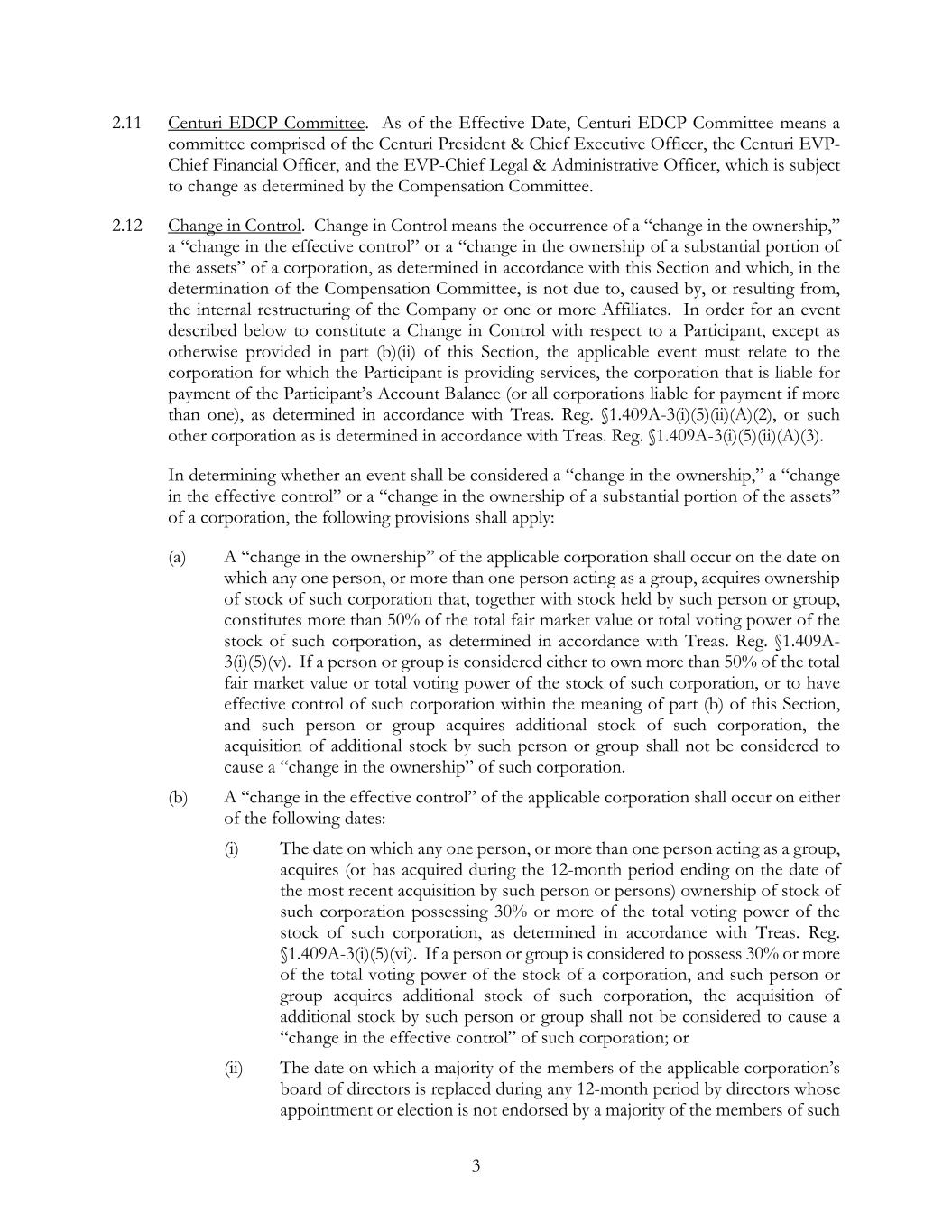
3 2.11 Centuri EDCP Committee. As of the Effective Date, Centuri EDCP Committee means a committee comprised of the Centuri President & Chief Executive Officer, the Centuri EVP- Chief Financial Officer, and the EVP-Chief Legal & Administrative Officer, which is subject to change as determined by the Compensation Committee. 2.12 Change in Control. Change in Control means the occurrence of a “change in the ownership,” a “change in the effective control” or a “change in the ownership of a substantial portion of the assets” of a corporation, as determined in accordance with this Section and which, in the determination of the Compensation Committee, is not due to, caused by, or resulting from, the internal restructuring of the Company or one or more Affiliates. In order for an event described below to constitute a Change in Control with respect to a Participant, except as otherwise provided in part (b)(ii) of this Section, the applicable event must relate to the corporation for which the Participant is providing services, the corporation that is liable for payment of the Participant’s Account Balance (or all corporations liable for payment if more than one), as determined in accordance with Treas. Reg. §1.409A-3(i)(5)(ii)(A)(2), or such other corporation as is determined in accordance with Treas. Reg. §1.409A-3(i)(5)(ii)(A)(3). In determining whether an event shall be considered a “change in the ownership,” a “change in the effective control” or a “change in the ownership of a substantial portion of the assets” of a corporation, the following provisions shall apply: (a) A “change in the ownership” of the applicable corporation shall occur on the date on which any one person, or more than one person acting as a group, acquires ownership of stock of such corporation that, together with stock held by such person or group, constitutes more than 50% of the total fair market value or total voting power of the stock of such corporation, as determined in accordance with Treas. Reg. §1.409A- 3(i)(5)(v). If a person or group is considered either to own more than 50% of the total fair market value or total voting power of the stock of such corporation, or to have effective control of such corporation within the meaning of part (b) of this Section, and such person or group acquires additional stock of such corporation, the acquisition of additional stock by such person or group shall not be considered to cause a “change in the ownership” of such corporation. (b) A “change in the effective control” of the applicable corporation shall occur on either of the following dates: (i) The date on which any one person, or more than one person acting as a group, acquires (or has acquired during the 12-month period ending on the date of the most recent acquisition by such person or persons) ownership of stock of such corporation possessing 30% or more of the total voting power of the stock of such corporation, as determined in accordance with Treas. Reg. §1.409A-3(i)(5)(vi). If a person or group is considered to possess 30% or more of the total voting power of the stock of a corporation, and such person or group acquires additional stock of such corporation, the acquisition of additional stock by such person or group shall not be considered to cause a “change in the effective control” of such corporation; or (ii) The date on which a majority of the members of the applicable corporation’s board of directors is replaced during any 12-month period by directors whose appointment or election is not endorsed by a majority of the members of such

4 corporation’s board of directors before the date of the appointment or election, as determined in accordance with Treas. Reg. §1.409A-3(i)(5)(vi). In determining whether the event described in the preceding sentence has occurred, the applicable corporation to which the event must relate shall only include a corporation identified in accordance with Treas. Reg. §1.409A- 3(i)(5)(ii) for which no other corporation is a majority shareholder. (c) A “change in the ownership of a substantial portion of the assets” of the applicable corporation shall occur on the date on which any one person, or more than one person acting as a group, acquires (or has acquired during the 12-month period ending on the date of the most recent acquisition by such person or persons) assets from the corporation that have a total gross fair market value equal to or more than 40% of the total gross fair market value of all of the assets of the corporation immediately before such acquisition or acquisitions, as determined in accordance with Treas. Reg. §1.409A-3(i)(5)(vii). A transfer of assets shall not be treated as a “change in the ownership of a substantial portion of the assets” when such transfer is made to an entity that is controlled by the shareholders of the transferor corporation, as determined in accordance with Treas. Reg. §1.409A-3(i)(5)(vii)(B). (d) The determination of whether an event constitutes a Change in Control shall be made in compliance with Treas. Reg. §1.409A-3(i)(5). Additionally, for purposes of this Plan, an event shall not constitute a Change in Control if, in the determination of the Compensation Committee, such event is due to, caused by, or resulting from, the internal restructuring of the Company or one or more Affiliates. 2.12 Change in Control Benefit. Change in Control Benefit means the benefit payable to a Participant under the Plan in the event of a Change in Control, as provided herein. 2.13 Claimant. Claimant means a Participant or Beneficiary filing a claim under Article XII of this Plan. 2.14 Code. Code means the Internal Revenue Code of 1986, as amended from time to time. 2.15 Code Section 409A. Code Section 409A means Section 409A of the Code, and regulations and other guidance issued by the Treasury Department and Internal Revenue Service thereunder. 2.16 Committee. Committee means the Compensation Committee who will administer the Plan with respect to executive officers and the Centuri EDCP Committee who will administer the Plan with respect to all other Participants; provided that the Compensation Committee may delegate to the Centuri EDCP Committee ministerial duties under the Plan with respect to executive officers. 2.17 Company. Company means Centuri Group, Inc., a Nevada corporation. 2.18 Compensation. Compensation means a Participant’s Salary, Bonus, and such other cash or equity-based compensation (if any) approved by the Committee as Compensation that may be deferred under this Plan. Compensation shall not include any compensation that has been previously deferred under this Plan or any other arrangement subject to Code Section 409A.
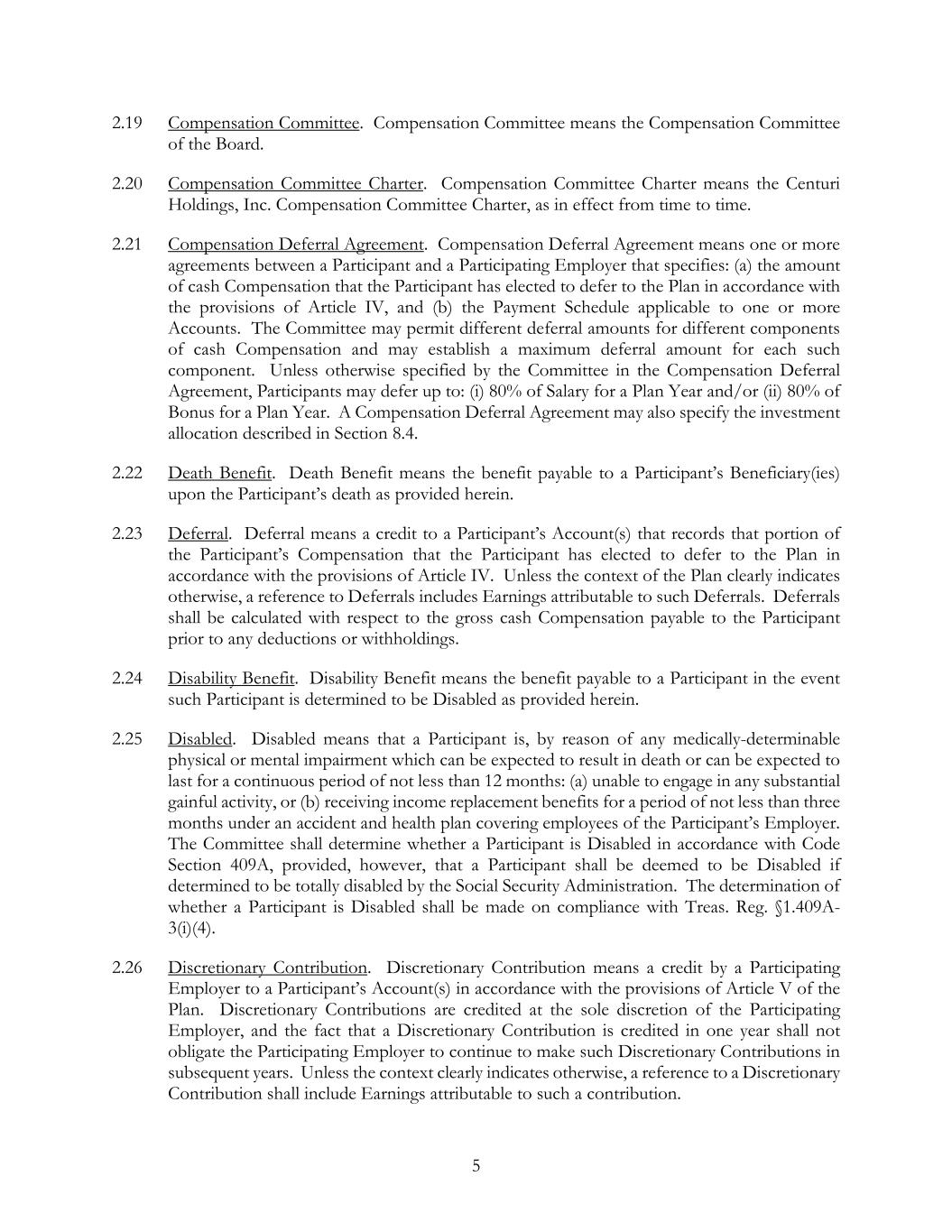
5 2.19 Compensation Committee. Compensation Committee means the Compensation Committee of the Board. 2.20 Compensation Committee Charter. Compensation Committee Charter means the Centuri Holdings, Inc. Compensation Committee Charter, as in effect from time to time. 2.21 Compensation Deferral Agreement. Compensation Deferral Agreement means one or more agreements between a Participant and a Participating Employer that specifies: (a) the amount of cash Compensation that the Participant has elected to defer to the Plan in accordance with the provisions of Article IV, and (b) the Payment Schedule applicable to one or more Accounts. The Committee may permit different deferral amounts for different components of cash Compensation and may establish a maximum deferral amount for each such component. Unless otherwise specified by the Committee in the Compensation Deferral Agreement, Participants may defer up to: (i) 80% of Salary for a Plan Year and/or (ii) 80% of Bonus for a Plan Year. A Compensation Deferral Agreement may also specify the investment allocation described in Section 8.4. 2.22 Death Benefit. Death Benefit means the benefit payable to a Participant’s Beneficiary(ies) upon the Participant’s death as provided herein. 2.23 Deferral. Deferral means a credit to a Participant’s Account(s) that records that portion of the Participant’s Compensation that the Participant has elected to defer to the Plan in accordance with the provisions of Article IV. Unless the context of the Plan clearly indicates otherwise, a reference to Deferrals includes Earnings attributable to such Deferrals. Deferrals shall be calculated with respect to the gross cash Compensation payable to the Participant prior to any deductions or withholdings. 2.24 Disability Benefit. Disability Benefit means the benefit payable to a Participant in the event such Participant is determined to be Disabled as provided herein. 2.25 Disabled. Disabled means that a Participant is, by reason of any medically-determinable physical or mental impairment which can be expected to result in death or can be expected to last for a continuous period of not less than 12 months: (a) unable to engage in any substantial gainful activity, or (b) receiving income replacement benefits for a period of not less than three months under an accident and health plan covering employees of the Participant’s Employer. The Committee shall determine whether a Participant is Disabled in accordance with Code Section 409A, provided, however, that a Participant shall be deemed to be Disabled if determined to be totally disabled by the Social Security Administration. The determination of whether a Participant is Disabled shall be made on compliance with Treas. Reg. §1.409A- 3(i)(4). 2.26 Discretionary Contribution. Discretionary Contribution means a credit by a Participating Employer to a Participant’s Account(s) in accordance with the provisions of Article V of the Plan. Discretionary Contributions are credited at the sole discretion of the Participating Employer, and the fact that a Discretionary Contribution is credited in one year shall not obligate the Participating Employer to continue to make such Discretionary Contributions in subsequent years. Unless the context clearly indicates otherwise, a reference to a Discretionary Contribution shall include Earnings attributable to such a contribution.
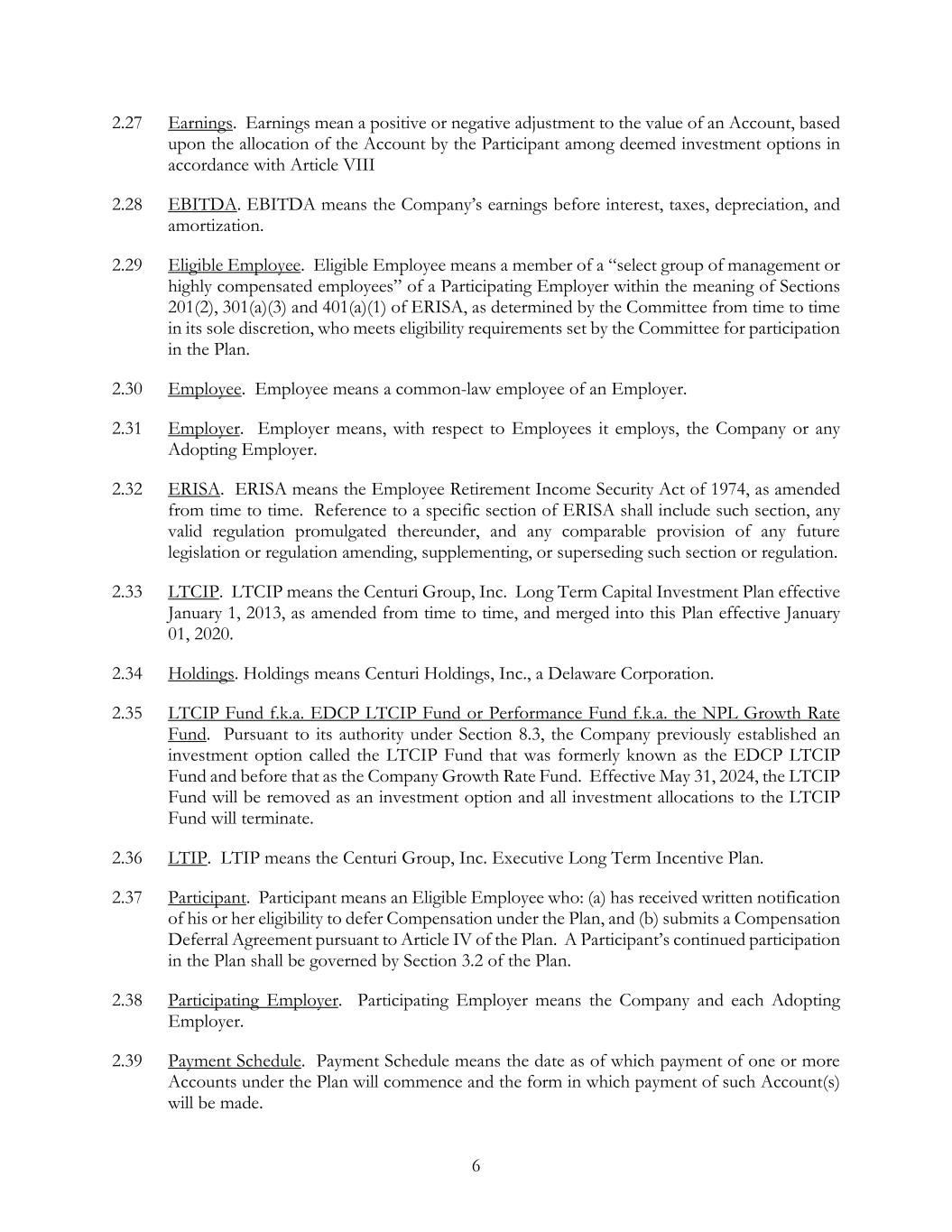
6 2.27 Earnings. Earnings mean a positive or negative adjustment to the value of an Account, based upon the allocation of the Account by the Participant among deemed investment options in accordance with Article VIII 2.28 EBITDA. EBITDA means the Company’s earnings before interest, taxes, depreciation, and amortization. 2.29 Eligible Employee. Eligible Employee means a member of a “select group of management or highly compensated employees” of a Participating Employer within the meaning of Sections 201(2), 301(a)(3) and 401(a)(1) of ERISA, as determined by the Committee from time to time in its sole discretion, who meets eligibility requirements set by the Committee for participation in the Plan. 2.30 Employee. Employee means a common-law employee of an Employer. 2.31 Employer. Employer means, with respect to Employees it employs, the Company or any Adopting Employer. 2.32 ERISA. ERISA means the Employee Retirement Income Security Act of 1974, as amended from time to time. Reference to a specific section of ERISA shall include such section, any valid regulation promulgated thereunder, and any comparable provision of any future legislation or regulation amending, supplementing, or superseding such section or regulation. 2.33 LTCIP. LTCIP means the Centuri Group, Inc. Long Term Capital Investment Plan effective January 1, 2013, as amended from time to time, and merged into this Plan effective January 01, 2020. 2.34 Holdings. Holdings means Centuri Holdings, Inc., a Delaware Corporation. 2.35 LTCIP Fund f.k.a. EDCP LTCIP Fund or Performance Fund f.k.a. the NPL Growth Rate Fund. Pursuant to its authority under Section 8.3, the Company previously established an investment option called the LTCIP Fund that was formerly known as the EDCP LTCIP Fund and before that as the Company Growth Rate Fund. Effective May 31, 2024, the LTCIP Fund will be removed as an investment option and all investment allocations to the LTCIP Fund will terminate. 2.36 LTIP. LTIP means the Centuri Group, Inc. Executive Long Term Incentive Plan. 2.37 Participant. Participant means an Eligible Employee who: (a) has received written notification of his or her eligibility to defer Compensation under the Plan, and (b) submits a Compensation Deferral Agreement pursuant to Article IV of the Plan. A Participant’s continued participation in the Plan shall be governed by Section 3.2 of the Plan. 2.38 Participating Employer. Participating Employer means the Company and each Adopting Employer. 2.39 Payment Schedule. Payment Schedule means the date as of which payment of one or more Accounts under the Plan will commence and the form in which payment of such Account(s) will be made.

7 2.40 Performance-Based Compensation. Performance-Based Compensation means any Bonus or other compensation amount to the extent that it is: (a) contingent on the satisfaction of pre- established organizational or individual performance criteria, (b) not readily ascertainable at the time the deferral election is made, and (c) based on services performed over a period of at least 12 months. For this purpose, performance criteria are “pre-established” if they are established in writing no later than 90 days after the commencement of the service period to which the criteria relate, provided that the outcome is substantially uncertain at the time the criteria are established. Performance-Based Compensation shall not include any Bonus or other compensation that is paid due to the Participant’s death, or because the Participant becomes Disabled, without regard to the satisfaction of the performance criteria. The determination of whether compensation is Performance Based Compensation shall be made in compliance with Treas. Reg. §1.409A-1(e). 2.41 Plan. Generally, the term Plan means the “Centuri Group, Inc. Executive Deferred Compensation Plan” as documented herein, and as may be amended from time to time hereafter. However, to the extent permitted or required under Code Section 409A, the term Plan may in the appropriate context also mean a portion of the Plan that is treated as a single plan under Treas. Reg. §1.409A-1(c), or the Plan or portion of the Plan and any other nonqualified deferred compensation plan or portion thereof that is treated as a single plan under such section. 2.42 Plan Year. Plan Year means a period beginning on January 1 and ending on December 31 of the same calendar year. 2.43 Retirement. Retirement means a Separation from Service of a Participant on or after attaining age 59 ½. 2.44 Salary. Salary means the Participant’s annual cash compensation for services performed for a Service Recipient during the applicable Plan Year, whether or not paid in such Plan Year, or included on the federal income tax form W-2 for such year, excluding Bonuses, commissions, stock options, stock appreciation rights, restricted stock, relocation expenses, payments of unused vacation days, long term or other incentive payments, non-monetary awards, other non-monetary compensation, severance pay, and other allowances paid to the Participant. Salary shall be calculated before reduction for compensation voluntarily deferred or contributed by Participant pursuant to all qualified or nonqualified plans of any Employer. 2.45 Separation from Service. With respect to a Service Provider who is an Employee, Separation from Service means either (a) termination of the Employee’s employment with the Company and all Affiliates due to death, Retirement, Termination or other reasons, or (b) a permanent reduction in the level of bona fide services the Employee provides to the Company and all Affiliates to an amount that is 20% or less of the average level of bona fide services the Employee provided to the Company in the immediately preceding 36 months, with the level of bona fide service calculated in accordance with Treasury Regulations Section 1.409A- 1(h)(1)(ii). For purposes of determining whether a Separation from Service has occurred, “Employer” is defined in accordance with Section 2.31 hereof, and the definition of “Affiliate” shall be modified by substituting 50% for 80% each place it appears in Code Section 1563(a)(1), (2) and (3), for purposes of Code Section 414(b), and each place it appears in Treasury Regulations Section 1.414(c)-2, for purposes of Code Section 414(c).
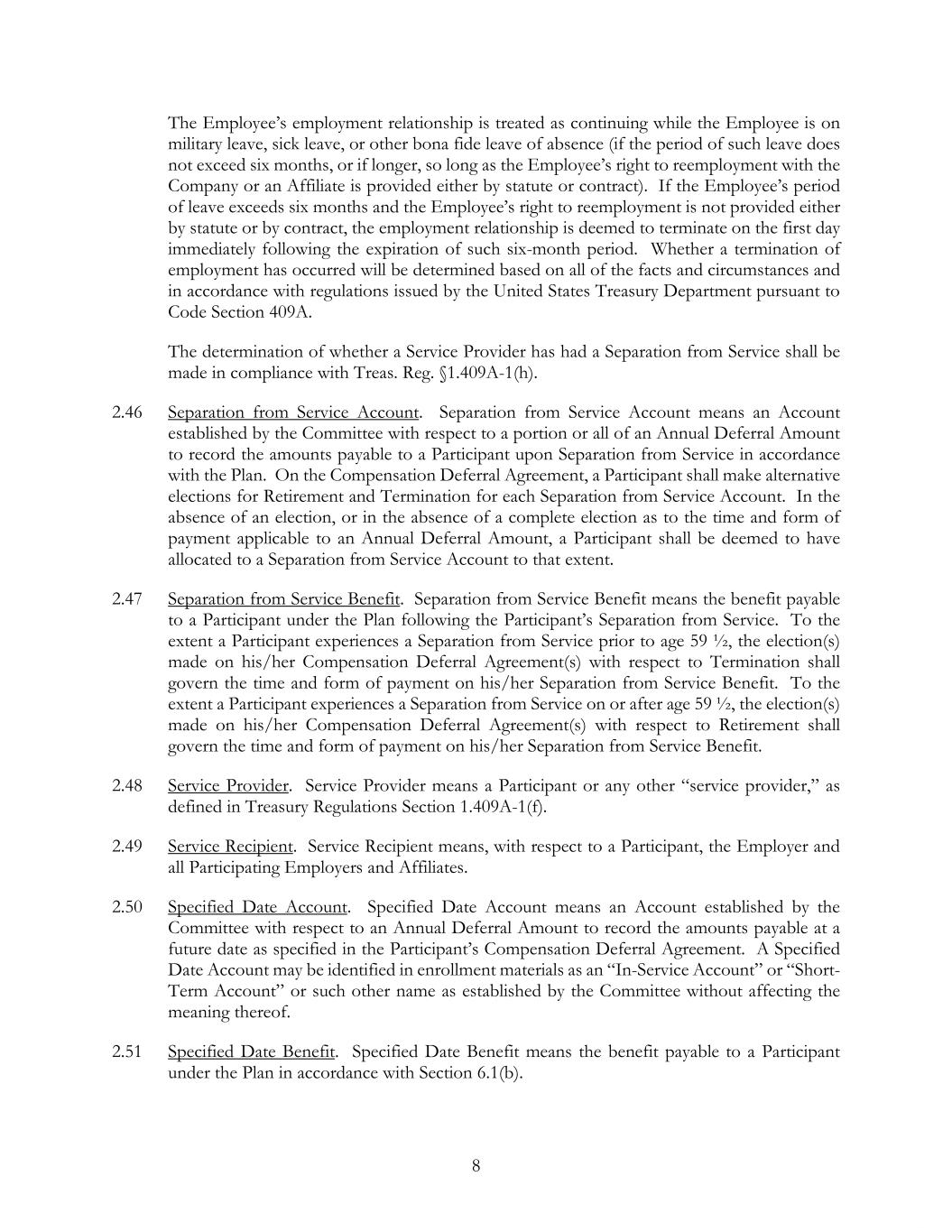
8 The Employee’s employment relationship is treated as continuing while the Employee is on military leave, sick leave, or other bona fide leave of absence (if the period of such leave does not exceed six months, or if longer, so long as the Employee’s right to reemployment with the Company or an Affiliate is provided either by statute or contract). If the Employee’s period of leave exceeds six months and the Employee’s right to reemployment is not provided either by statute or by contract, the employment relationship is deemed to terminate on the first day immediately following the expiration of such six-month period. Whether a termination of employment has occurred will be determined based on all of the facts and circumstances and in accordance with regulations issued by the United States Treasury Department pursuant to Code Section 409A. The determination of whether a Service Provider has had a Separation from Service shall be made in compliance with Treas. Reg. §1.409A-1(h). 2.46 Separation from Service Account. Separation from Service Account means an Account established by the Committee with respect to a portion or all of an Annual Deferral Amount to record the amounts payable to a Participant upon Separation from Service in accordance with the Plan. On the Compensation Deferral Agreement, a Participant shall make alternative elections for Retirement and Termination for each Separation from Service Account. In the absence of an election, or in the absence of a complete election as to the time and form of payment applicable to an Annual Deferral Amount, a Participant shall be deemed to have allocated to a Separation from Service Account to that extent. 2.47 Separation from Service Benefit. Separation from Service Benefit means the benefit payable to a Participant under the Plan following the Participant’s Separation from Service. To the extent a Participant experiences a Separation from Service prior to age 59 ½, the election(s) made on his/her Compensation Deferral Agreement(s) with respect to Termination shall govern the time and form of payment on his/her Separation from Service Benefit. To the extent a Participant experiences a Separation from Service on or after age 59 ½, the election(s) made on his/her Compensation Deferral Agreement(s) with respect to Retirement shall govern the time and form of payment on his/her Separation from Service Benefit. 2.48 Service Provider. Service Provider means a Participant or any other “service provider,” as defined in Treasury Regulations Section 1.409A-1(f). 2.49 Service Recipient. Service Recipient means, with respect to a Participant, the Employer and all Participating Employers and Affiliates. 2.50 Specified Date Account. Specified Date Account means an Account established by the Committee with respect to an Annual Deferral Amount to record the amounts payable at a future date as specified in the Participant’s Compensation Deferral Agreement. A Specified Date Account may be identified in enrollment materials as an “In-Service Account” or “Short- Term Account” or such other name as established by the Committee without affecting the meaning thereof. 2.51 Specified Date Benefit. Specified Date Benefit means the benefit payable to a Participant under the Plan in accordance with Section 6.1(b).
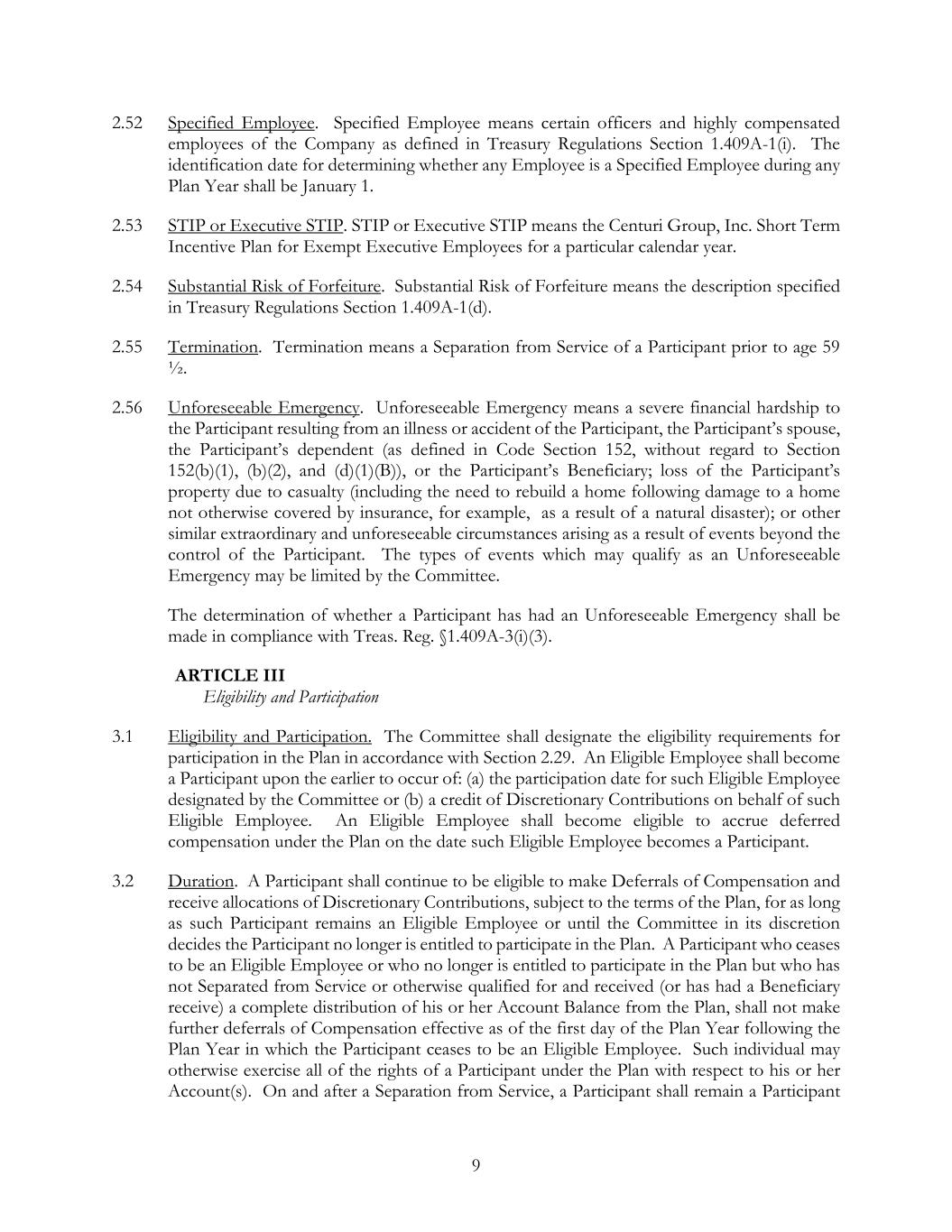
9 2.52 Specified Employee. Specified Employee means certain officers and highly compensated employees of the Company as defined in Treasury Regulations Section 1.409A-1(i). The identification date for determining whether any Employee is a Specified Employee during any Plan Year shall be January 1. 2.53 STIP or Executive STIP. STIP or Executive STIP means the Centuri Group, Inc. Short Term Incentive Plan for Exempt Executive Employees for a particular calendar year. 2.54 Substantial Risk of Forfeiture. Substantial Risk of Forfeiture means the description specified in Treasury Regulations Section 1.409A-1(d). 2.55 Termination. Termination means a Separation from Service of a Participant prior to age 59 ½. 2.56 Unforeseeable Emergency. Unforeseeable Emergency means a severe financial hardship to the Participant resulting from an illness or accident of the Participant, the Participant’s spouse, the Participant’s dependent (as defined in Code Section 152, without regard to Section 152(b)(1), (b)(2), and (d)(1)(B)), or the Participant’s Beneficiary; loss of the Participant’s property due to casualty (including the need to rebuild a home following damage to a home not otherwise covered by insurance, for example, as a result of a natural disaster); or other similar extraordinary and unforeseeable circumstances arising as a result of events beyond the control of the Participant. The types of events which may qualify as an Unforeseeable Emergency may be limited by the Committee. The determination of whether a Participant has had an Unforeseeable Emergency shall be made in compliance with Treas. Reg. §1.409A-3(i)(3). ARTICLE III Eligibility and Participation 3.1 Eligibility and Participation. The Committee shall designate the eligibility requirements for participation in the Plan in accordance with Section 2.29. An Eligible Employee shall become a Participant upon the earlier to occur of: (a) the participation date for such Eligible Employee designated by the Committee or (b) a credit of Discretionary Contributions on behalf of such Eligible Employee. An Eligible Employee shall become eligible to accrue deferred compensation under the Plan on the date such Eligible Employee becomes a Participant. 3.2 Duration. A Participant shall continue to be eligible to make Deferrals of Compensation and receive allocations of Discretionary Contributions, subject to the terms of the Plan, for as long as such Participant remains an Eligible Employee or until the Committee in its discretion decides the Participant no longer is entitled to participate in the Plan. A Participant who ceases to be an Eligible Employee or who no longer is entitled to participate in the Plan but who has not Separated from Service or otherwise qualified for and received (or has had a Beneficiary receive) a complete distribution of his or her Account Balance from the Plan, shall not make further deferrals of Compensation effective as of the first day of the Plan Year following the Plan Year in which the Participant ceases to be an Eligible Employee. Such individual may otherwise exercise all of the rights of a Participant under the Plan with respect to his or her Account(s). On and after a Separation from Service, a Participant shall remain a Participant
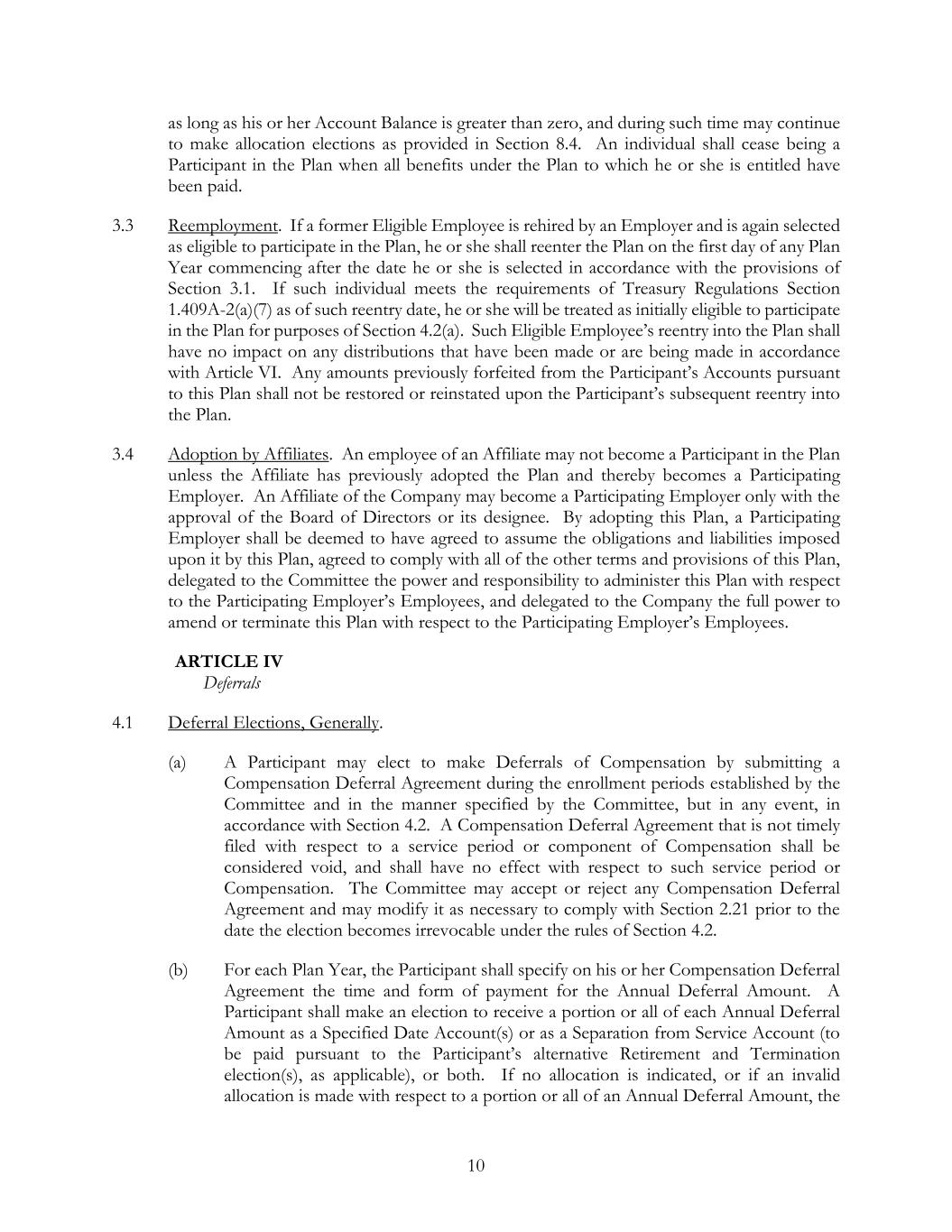
10 as long as his or her Account Balance is greater than zero, and during such time may continue to make allocation elections as provided in Section 8.4. An individual shall cease being a Participant in the Plan when all benefits under the Plan to which he or she is entitled have been paid. 3.3 Reemployment. If a former Eligible Employee is rehired by an Employer and is again selected as eligible to participate in the Plan, he or she shall reenter the Plan on the first day of any Plan Year commencing after the date he or she is selected in accordance with the provisions of Section 3.1. If such individual meets the requirements of Treasury Regulations Section 1.409A-2(a)(7) as of such reentry date, he or she will be treated as initially eligible to participate in the Plan for purposes of Section 4.2(a). Such Eligible Employee’s reentry into the Plan shall have no impact on any distributions that have been made or are being made in accordance with Article VI. Any amounts previously forfeited from the Participant’s Accounts pursuant to this Plan shall not be restored or reinstated upon the Participant’s subsequent reentry into the Plan. 3.4 Adoption by Affiliates. An employee of an Affiliate may not become a Participant in the Plan unless the Affiliate has previously adopted the Plan and thereby becomes a Participating Employer. An Affiliate of the Company may become a Participating Employer only with the approval of the Board of Directors or its designee. By adopting this Plan, a Participating Employer shall be deemed to have agreed to assume the obligations and liabilities imposed upon it by this Plan, agreed to comply with all of the other terms and provisions of this Plan, delegated to the Committee the power and responsibility to administer this Plan with respect to the Participating Employer’s Employees, and delegated to the Company the full power to amend or terminate this Plan with respect to the Participating Employer’s Employees. ARTICLE IV Deferrals 4.1 Deferral Elections, Generally. (a) A Participant may elect to make Deferrals of Compensation by submitting a Compensation Deferral Agreement during the enrollment periods established by the Committee and in the manner specified by the Committee, but in any event, in accordance with Section 4.2. A Compensation Deferral Agreement that is not timely filed with respect to a service period or component of Compensation shall be considered void, and shall have no effect with respect to such service period or Compensation. The Committee may accept or reject any Compensation Deferral Agreement and may modify it as necessary to comply with Section 2.21 prior to the date the election becomes irrevocable under the rules of Section 4.2. (b) For each Plan Year, the Participant shall specify on his or her Compensation Deferral Agreement the time and form of payment for the Annual Deferral Amount. A Participant shall make an election to receive a portion or all of each Annual Deferral Amount as a Specified Date Account(s) or as a Separation from Service Account (to be paid pursuant to the Participant’s alternative Retirement and Termination election(s), as applicable), or both. If no allocation is indicated, or if an invalid allocation is made with respect to a portion or all of an Annual Deferral Amount, the
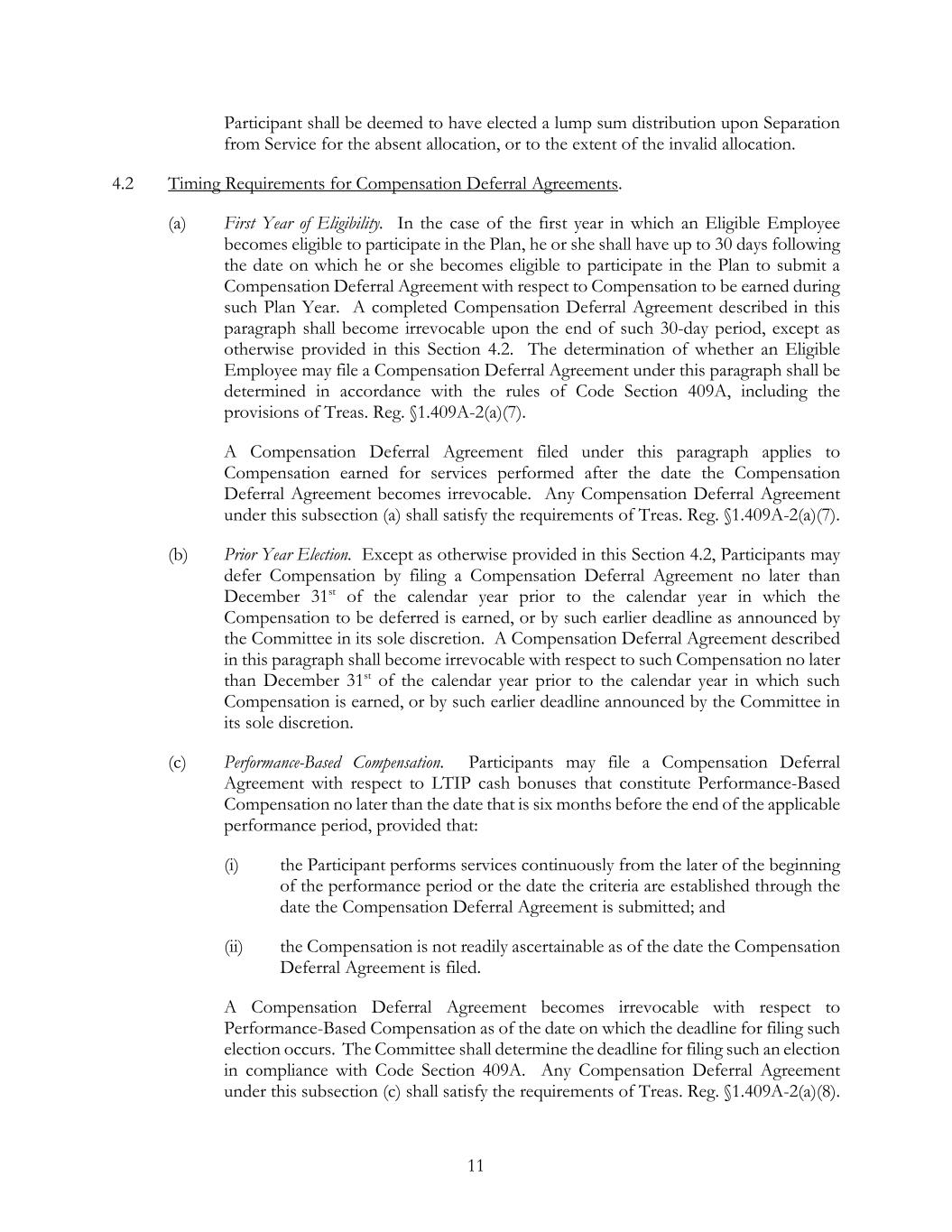
11 Participant shall be deemed to have elected a lump sum distribution upon Separation from Service for the absent allocation, or to the extent of the invalid allocation. 4.2 Timing Requirements for Compensation Deferral Agreements. (a) First Year of Eligibility. In the case of the first year in which an Eligible Employee becomes eligible to participate in the Plan, he or she shall have up to 30 days following the date on which he or she becomes eligible to participate in the Plan to submit a Compensation Deferral Agreement with respect to Compensation to be earned during such Plan Year. A completed Compensation Deferral Agreement described in this paragraph shall become irrevocable upon the end of such 30-day period, except as otherwise provided in this Section 4.2. The determination of whether an Eligible Employee may file a Compensation Deferral Agreement under this paragraph shall be determined in accordance with the rules of Code Section 409A, including the provisions of Treas. Reg. §1.409A-2(a)(7). A Compensation Deferral Agreement filed under this paragraph applies to Compensation earned for services performed after the date the Compensation Deferral Agreement becomes irrevocable. Any Compensation Deferral Agreement under this subsection (a) shall satisfy the requirements of Treas. Reg. §1.409A-2(a)(7). (b) Prior Year Election. Except as otherwise provided in this Section 4.2, Participants may defer Compensation by filing a Compensation Deferral Agreement no later than December 31st of the calendar year prior to the calendar year in which the Compensation to be deferred is earned, or by such earlier deadline as announced by the Committee in its sole discretion. A Compensation Deferral Agreement described in this paragraph shall become irrevocable with respect to such Compensation no later than December 31st of the calendar year prior to the calendar year in which such Compensation is earned, or by such earlier deadline announced by the Committee in its sole discretion. (c) Performance-Based Compensation. Participants may file a Compensation Deferral Agreement with respect to LTIP cash bonuses that constitute Performance-Based Compensation no later than the date that is six months before the end of the applicable performance period, provided that: (i) the Participant performs services continuously from the later of the beginning of the performance period or the date the criteria are established through the date the Compensation Deferral Agreement is submitted; and (ii) the Compensation is not readily ascertainable as of the date the Compensation Deferral Agreement is filed. A Compensation Deferral Agreement becomes irrevocable with respect to Performance-Based Compensation as of the date on which the deadline for filing such election occurs. The Committee shall determine the deadline for filing such an election in compliance with Code Section 409A. Any Compensation Deferral Agreement under this subsection (c) shall satisfy the requirements of Treas. Reg. §1.409A-2(a)(8).
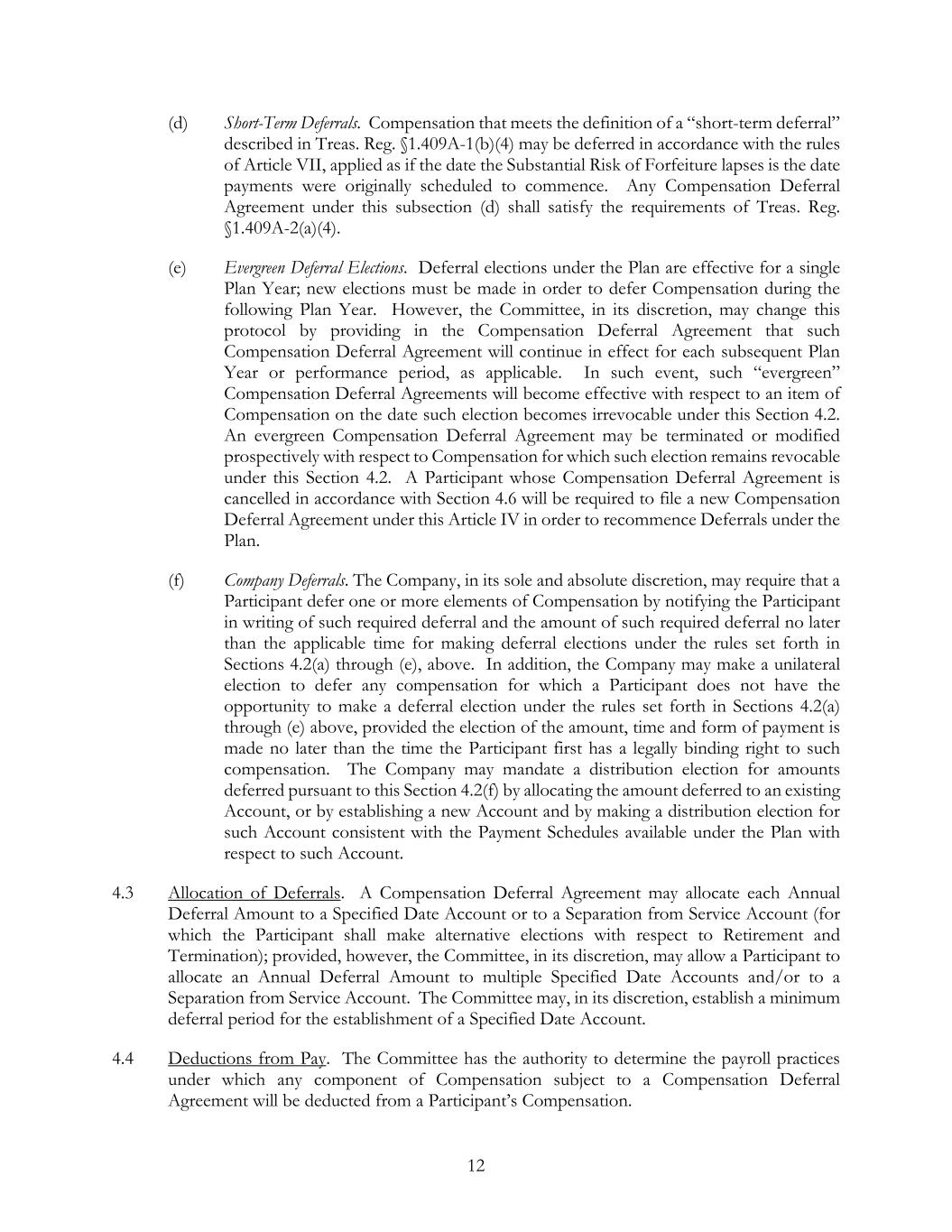
12 (d) Short-Term Deferrals. Compensation that meets the definition of a “short-term deferral” described in Treas. Reg. §1.409A-1(b)(4) may be deferred in accordance with the rules of Article VII, applied as if the date the Substantial Risk of Forfeiture lapses is the date payments were originally scheduled to commence. Any Compensation Deferral Agreement under this subsection (d) shall satisfy the requirements of Treas. Reg. §1.409A-2(a)(4). (e) Evergreen Deferral Elections. Deferral elections under the Plan are effective for a single Plan Year; new elections must be made in order to defer Compensation during the following Plan Year. However, the Committee, in its discretion, may change this protocol by providing in the Compensation Deferral Agreement that such Compensation Deferral Agreement will continue in effect for each subsequent Plan Year or performance period, as applicable. In such event, such “evergreen” Compensation Deferral Agreements will become effective with respect to an item of Compensation on the date such election becomes irrevocable under this Section 4.2. An evergreen Compensation Deferral Agreement may be terminated or modified prospectively with respect to Compensation for which such election remains revocable under this Section 4.2. A Participant whose Compensation Deferral Agreement is cancelled in accordance with Section 4.6 will be required to file a new Compensation Deferral Agreement under this Article IV in order to recommence Deferrals under the Plan. (f) Company Deferrals. The Company, in its sole and absolute discretion, may require that a Participant defer one or more elements of Compensation by notifying the Participant in writing of such required deferral and the amount of such required deferral no later than the applicable time for making deferral elections under the rules set forth in Sections 4.2(a) through (e), above. In addition, the Company may make a unilateral election to defer any compensation for which a Participant does not have the opportunity to make a deferral election under the rules set forth in Sections 4.2(a) through (e) above, provided the election of the amount, time and form of payment is made no later than the time the Participant first has a legally binding right to such compensation. The Company may mandate a distribution election for amounts deferred pursuant to this Section 4.2(f) by allocating the amount deferred to an existing Account, or by establishing a new Account and by making a distribution election for such Account consistent with the Payment Schedules available under the Plan with respect to such Account. 4.3 Allocation of Deferrals. A Compensation Deferral Agreement may allocate each Annual Deferral Amount to a Specified Date Account or to a Separation from Service Account (for which the Participant shall make alternative elections with respect to Retirement and Termination); provided, however, the Committee, in its discretion, may allow a Participant to allocate an Annual Deferral Amount to multiple Specified Date Accounts and/or to a Separation from Service Account. The Committee may, in its discretion, establish a minimum deferral period for the establishment of a Specified Date Account. 4.4 Deductions from Pay. The Committee has the authority to determine the payroll practices under which any component of Compensation subject to a Compensation Deferral Agreement will be deducted from a Participant’s Compensation.
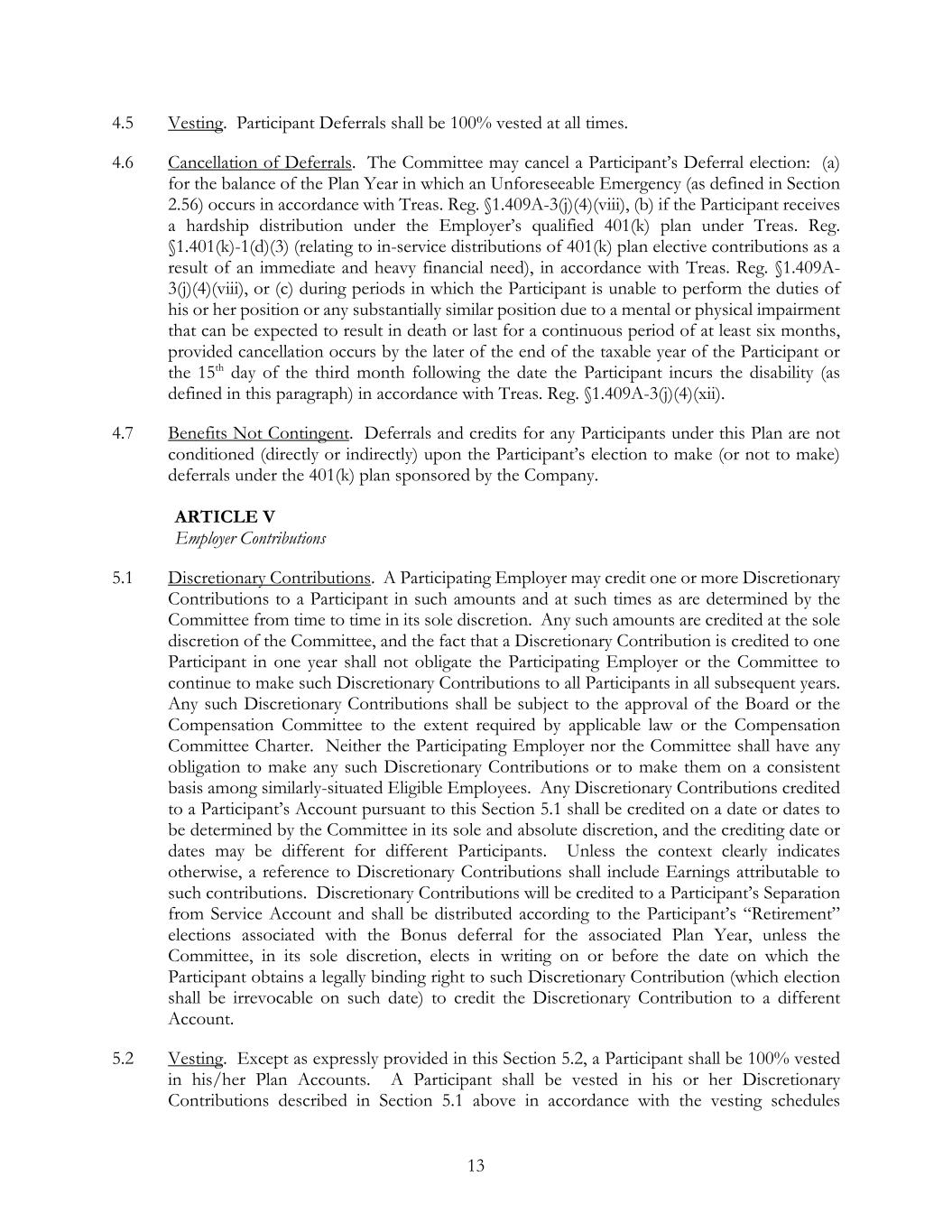
13 4.5 Vesting. Participant Deferrals shall be 100% vested at all times. 4.6 Cancellation of Deferrals. The Committee may cancel a Participant’s Deferral election: (a) for the balance of the Plan Year in which an Unforeseeable Emergency (as defined in Section 2.56) occurs in accordance with Treas. Reg. §1.409A-3(j)(4)(viii), (b) if the Participant receives a hardship distribution under the Employer’s qualified 401(k) plan under Treas. Reg. §1.401(k)-1(d)(3) (relating to in-service distributions of 401(k) plan elective contributions as a result of an immediate and heavy financial need), in accordance with Treas. Reg. §1.409A- 3(j)(4)(viii), or (c) during periods in which the Participant is unable to perform the duties of his or her position or any substantially similar position due to a mental or physical impairment that can be expected to result in death or last for a continuous period of at least six months, provided cancellation occurs by the later of the end of the taxable year of the Participant or the 15th day of the third month following the date the Participant incurs the disability (as defined in this paragraph) in accordance with Treas. Reg. §1.409A-3(j)(4)(xii). 4.7 Benefits Not Contingent. Deferrals and credits for any Participants under this Plan are not conditioned (directly or indirectly) upon the Participant’s election to make (or not to make) deferrals under the 401(k) plan sponsored by the Company. ARTICLE V Employer Contributions 5.1 Discretionary Contributions. A Participating Employer may credit one or more Discretionary Contributions to a Participant in such amounts and at such times as are determined by the Committee from time to time in its sole discretion. Any such amounts are credited at the sole discretion of the Committee, and the fact that a Discretionary Contribution is credited to one Participant in one year shall not obligate the Participating Employer or the Committee to continue to make such Discretionary Contributions to all Participants in all subsequent years. Any such Discretionary Contributions shall be subject to the approval of the Board or the Compensation Committee to the extent required by applicable law or the Compensation Committee Charter. Neither the Participating Employer nor the Committee shall have any obligation to make any such Discretionary Contributions or to make them on a consistent basis among similarly-situated Eligible Employees. Any Discretionary Contributions credited to a Participant’s Account pursuant to this Section 5.1 shall be credited on a date or dates to be determined by the Committee in its sole and absolute discretion, and the crediting date or dates may be different for different Participants. Unless the context clearly indicates otherwise, a reference to Discretionary Contributions shall include Earnings attributable to such contributions. Discretionary Contributions will be credited to a Participant’s Separation from Service Account and shall be distributed according to the Participant’s “Retirement” elections associated with the Bonus deferral for the associated Plan Year, unless the Committee, in its sole discretion, elects in writing on or before the date on which the Participant obtains a legally binding right to such Discretionary Contribution (which election shall be irrevocable on such date) to credit the Discretionary Contribution to a different Account. 5.2 Vesting. Except as expressly provided in this Section 5.2, a Participant shall be 100% vested in his/her Plan Accounts. A Participant shall be vested in his or her Discretionary Contributions described in Section 5.1 above in accordance with the vesting schedules
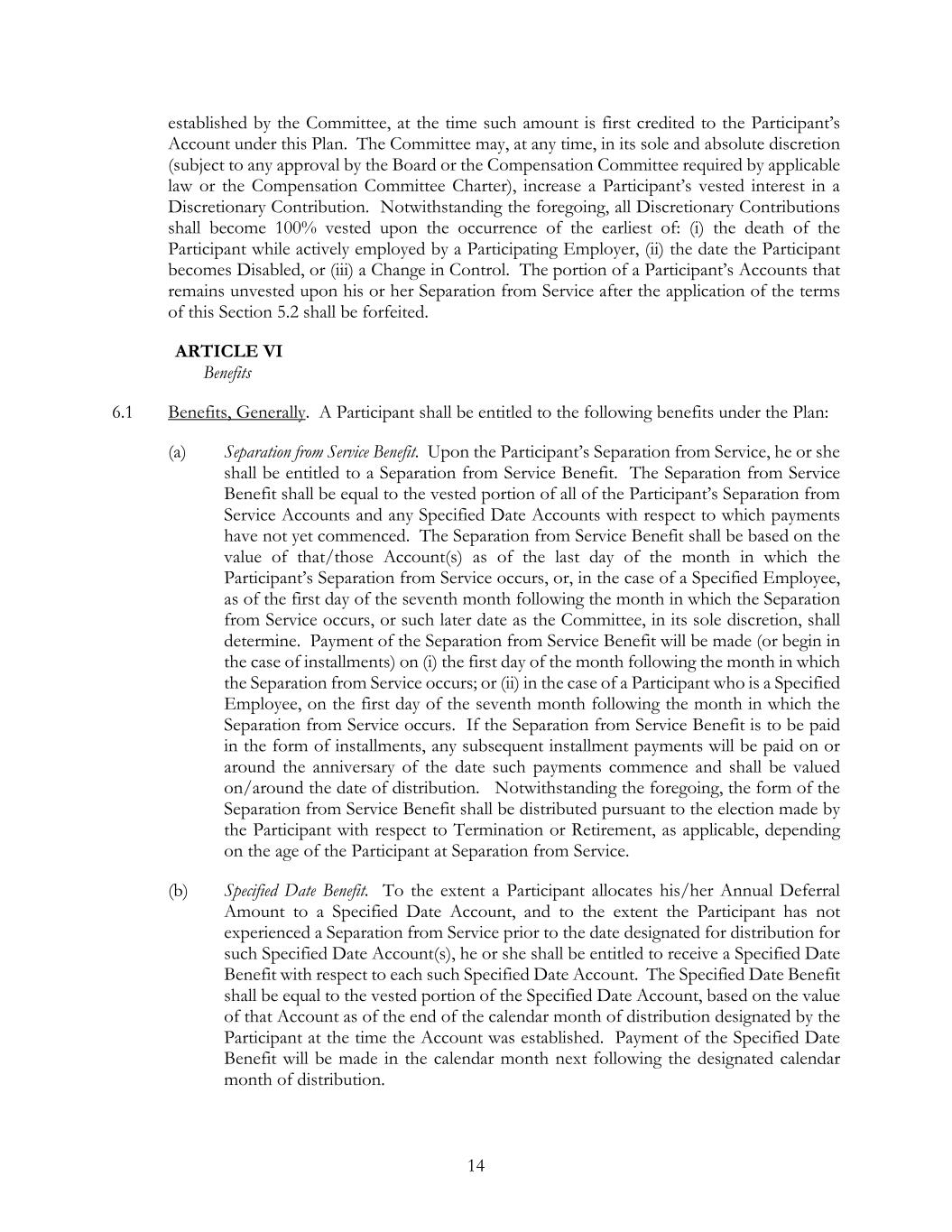
14 established by the Committee, at the time such amount is first credited to the Participant’s Account under this Plan. The Committee may, at any time, in its sole and absolute discretion (subject to any approval by the Board or the Compensation Committee required by applicable law or the Compensation Committee Charter), increase a Participant’s vested interest in a Discretionary Contribution. Notwithstanding the foregoing, all Discretionary Contributions shall become 100% vested upon the occurrence of the earliest of: (i) the death of the Participant while actively employed by a Participating Employer, (ii) the date the Participant becomes Disabled, or (iii) a Change in Control. The portion of a Participant’s Accounts that remains unvested upon his or her Separation from Service after the application of the terms of this Section 5.2 shall be forfeited. ARTICLE VI Benefits 6.1 Benefits, Generally. A Participant shall be entitled to the following benefits under the Plan: (a) Separation from Service Benefit. Upon the Participant’s Separation from Service, he or she shall be entitled to a Separation from Service Benefit. The Separation from Service Benefit shall be equal to the vested portion of all of the Participant’s Separation from Service Accounts and any Specified Date Accounts with respect to which payments have not yet commenced. The Separation from Service Benefit shall be based on the value of that/those Account(s) as of the last day of the month in which the Participant’s Separation from Service occurs, or, in the case of a Specified Employee, as of the first day of the seventh month following the month in which the Separation from Service occurs, or such later date as the Committee, in its sole discretion, shall determine. Payment of the Separation from Service Benefit will be made (or begin in the case of installments) on (i) the first day of the month following the month in which the Separation from Service occurs; or (ii) in the case of a Participant who is a Specified Employee, on the first day of the seventh month following the month in which the Separation from Service occurs. If the Separation from Service Benefit is to be paid in the form of installments, any subsequent installment payments will be paid on or around the anniversary of the date such payments commence and shall be valued on/around the date of distribution. Notwithstanding the foregoing, the form of the Separation from Service Benefit shall be distributed pursuant to the election made by the Participant with respect to Termination or Retirement, as applicable, depending on the age of the Participant at Separation from Service. (b) Specified Date Benefit. To the extent a Participant allocates his/her Annual Deferral Amount to a Specified Date Account, and to the extent the Participant has not experienced a Separation from Service prior to the date designated for distribution for such Specified Date Account(s), he or she shall be entitled to receive a Specified Date Benefit with respect to each such Specified Date Account. The Specified Date Benefit shall be equal to the vested portion of the Specified Date Account, based on the value of that Account as of the end of the calendar month of distribution designated by the Participant at the time the Account was established. Payment of the Specified Date Benefit will be made in the calendar month next following the designated calendar month of distribution.
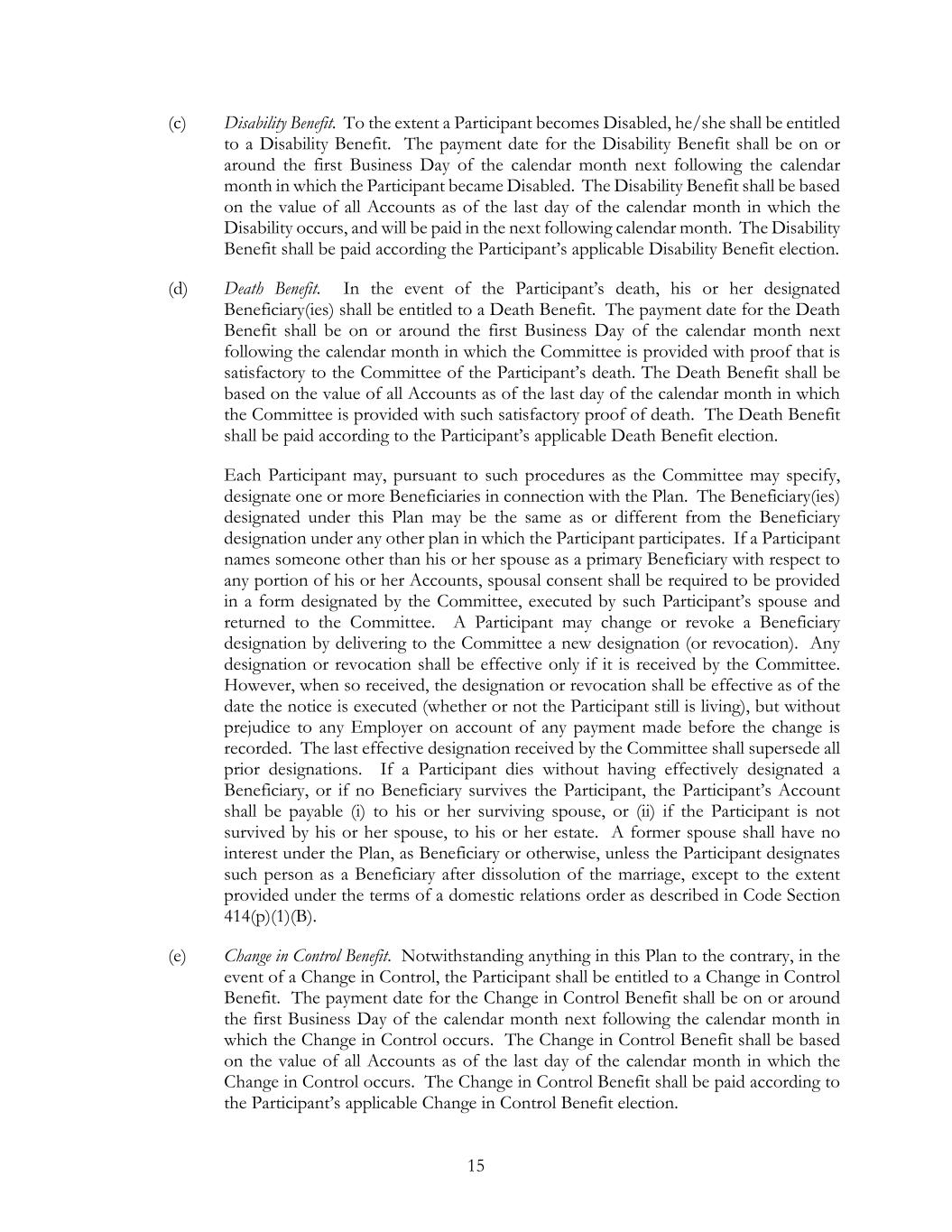
15 (c) Disability Benefit. To the extent a Participant becomes Disabled, he/she shall be entitled to a Disability Benefit. The payment date for the Disability Benefit shall be on or around the first Business Day of the calendar month next following the calendar month in which the Participant became Disabled. The Disability Benefit shall be based on the value of all Accounts as of the last day of the calendar month in which the Disability occurs, and will be paid in the next following calendar month. The Disability Benefit shall be paid according the Participant’s applicable Disability Benefit election. (d) Death Benefit. In the event of the Participant’s death, his or her designated Beneficiary(ies) shall be entitled to a Death Benefit. The payment date for the Death Benefit shall be on or around the first Business Day of the calendar month next following the calendar month in which the Committee is provided with proof that is satisfactory to the Committee of the Participant’s death. The Death Benefit shall be based on the value of all Accounts as of the last day of the calendar month in which the Committee is provided with such satisfactory proof of death. The Death Benefit shall be paid according to the Participant’s applicable Death Benefit election. Each Participant may, pursuant to such procedures as the Committee may specify, designate one or more Beneficiaries in connection with the Plan. The Beneficiary(ies) designated under this Plan may be the same as or different from the Beneficiary designation under any other plan in which the Participant participates. If a Participant names someone other than his or her spouse as a primary Beneficiary with respect to any portion of his or her Accounts, spousal consent shall be required to be provided in a form designated by the Committee, executed by such Participant’s spouse and returned to the Committee. A Participant may change or revoke a Beneficiary designation by delivering to the Committee a new designation (or revocation). Any designation or revocation shall be effective only if it is received by the Committee. However, when so received, the designation or revocation shall be effective as of the date the notice is executed (whether or not the Participant still is living), but without prejudice to any Employer on account of any payment made before the change is recorded. The last effective designation received by the Committee shall supersede all prior designations. If a Participant dies without having effectively designated a Beneficiary, or if no Beneficiary survives the Participant, the Participant’s Account shall be payable (i) to his or her surviving spouse, or (ii) if the Participant is not survived by his or her spouse, to his or her estate. A former spouse shall have no interest under the Plan, as Beneficiary or otherwise, unless the Participant designates such person as a Beneficiary after dissolution of the marriage, except to the extent provided under the terms of a domestic relations order as described in Code Section 414(p)(1)(B). (e) Change in Control Benefit. Notwithstanding anything in this Plan to the contrary, in the event of a Change in Control, the Participant shall be entitled to a Change in Control Benefit. The payment date for the Change in Control Benefit shall be on or around the first Business Day of the calendar month next following the calendar month in which the Change in Control occurs. The Change in Control Benefit shall be based on the value of all Accounts as of the last day of the calendar month in which the Change in Control occurs. The Change in Control Benefit shall be paid according to the Participant’s applicable Change in Control Benefit election.
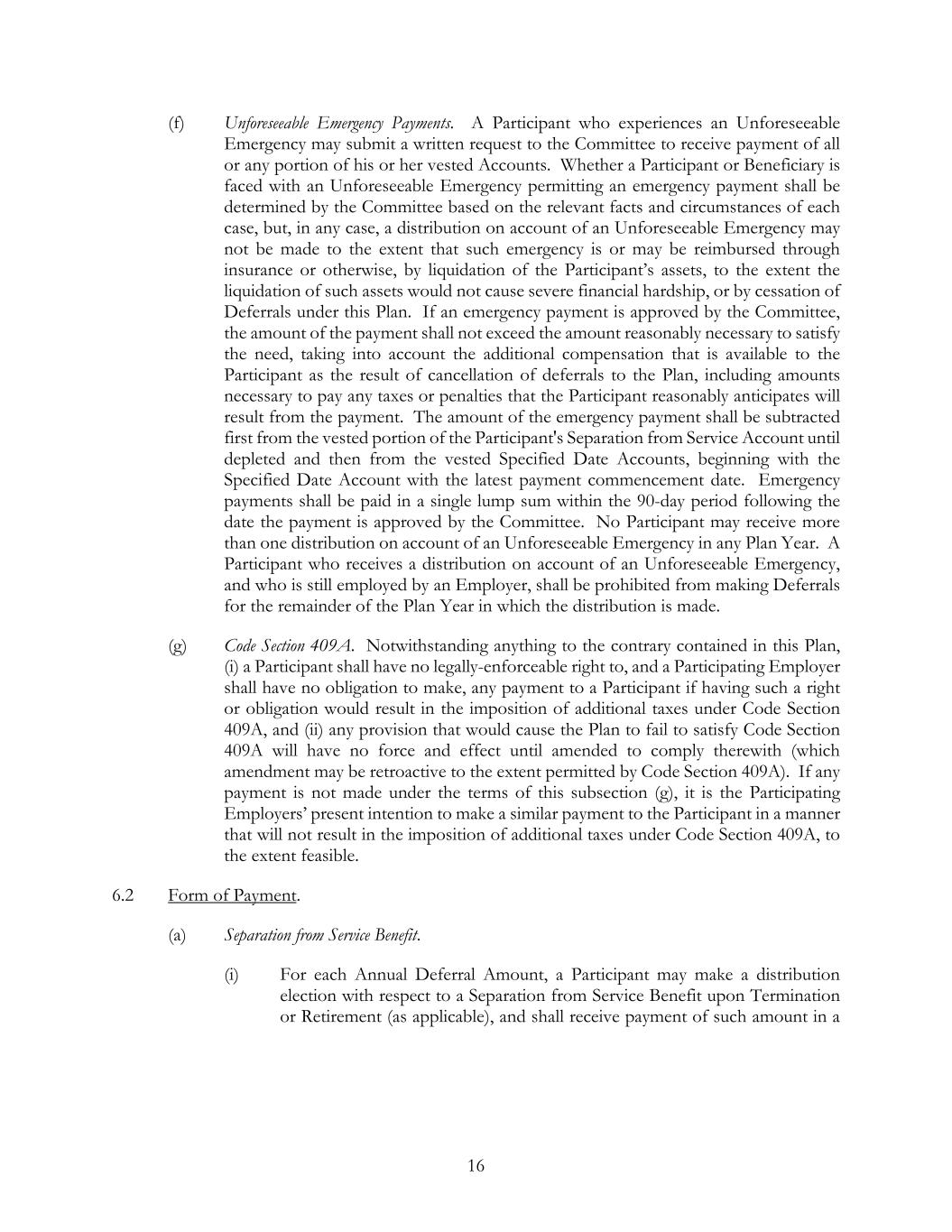
16 (f) Unforeseeable Emergency Payments. A Participant who experiences an Unforeseeable Emergency may submit a written request to the Committee to receive payment of all or any portion of his or her vested Accounts. Whether a Participant or Beneficiary is faced with an Unforeseeable Emergency permitting an emergency payment shall be determined by the Committee based on the relevant facts and circumstances of each case, but, in any case, a distribution on account of an Unforeseeable Emergency may not be made to the extent that such emergency is or may be reimbursed through insurance or otherwise, by liquidation of the Participant’s assets, to the extent the liquidation of such assets would not cause severe financial hardship, or by cessation of Deferrals under this Plan. If an emergency payment is approved by the Committee, the amount of the payment shall not exceed the amount reasonably necessary to satisfy the need, taking into account the additional compensation that is available to the Participant as the result of cancellation of deferrals to the Plan, including amounts necessary to pay any taxes or penalties that the Participant reasonably anticipates will result from the payment. The amount of the emergency payment shall be subtracted first from the vested portion of the Participant's Separation from Service Account until depleted and then from the vested Specified Date Accounts, beginning with the Specified Date Account with the latest payment commencement date. Emergency payments shall be paid in a single lump sum within the 90-day period following the date the payment is approved by the Committee. No Participant may receive more than one distribution on account of an Unforeseeable Emergency in any Plan Year. A Participant who receives a distribution on account of an Unforeseeable Emergency, and who is still employed by an Employer, shall be prohibited from making Deferrals for the remainder of the Plan Year in which the distribution is made. (g) Code Section 409A. Notwithstanding anything to the contrary contained in this Plan, (i) a Participant shall have no legally-enforceable right to, and a Participating Employer shall have no obligation to make, any payment to a Participant if having such a right or obligation would result in the imposition of additional taxes under Code Section 409A, and (ii) any provision that would cause the Plan to fail to satisfy Code Section 409A will have no force and effect until amended to comply therewith (which amendment may be retroactive to the extent permitted by Code Section 409A). If any payment is not made under the terms of this subsection (g), it is the Participating Employers’ present intention to make a similar payment to the Participant in a manner that will not result in the imposition of additional taxes under Code Section 409A, to the extent feasible. 6.2 Form of Payment. (a) Separation from Service Benefit. (i) For each Annual Deferral Amount, a Participant may make a distribution election with respect to a Separation from Service Benefit upon Termination or Retirement (as applicable), and shall receive payment of such amount in a

17 single lump sum, unless the Participant elects an alternate form of payment upon Termination or Retirement. (ii) Permissible alternate forms of payment for the Separation from Service Benefit upon Termination or Retirement (as applicable) are annual installments over a period of two to ten years, as elected by the Participant. (b) Specified Date Benefit. A Participant who elects to receive an Annual Deferral Amount in the form of a Specified Date Benefit shall receive payment of such amount in a single lump sum. Notwithstanding any Specified Date election of a Participant, if a Participant dies, experiences a Disability, or Separates from Service before distributions with respect to a Specified Date Account have commenced, such amounts shall be paid in accordance with the time and form of payment applicable to the Participant’s Separation from Service Benefit, Disability Benefit or Death Benefit (as applicable). (c) Disability Benefit. For each Annual Deferral Amount, a Participant may make a distribution election with respect to the applicable Disability Benefit. Permissible forms of payment are a single lump sum, or annual installments over a period of two to ten years. In the absence of a Disability Benefit election for an Annual Deferral Amount, or in the event of an invalid election, the Participant shall be deemed to have elected to receive payment of such amount in a single lump sum. (d) Death Benefit. For each Annual Deferral Amount, a Participant may make a distribution election with respect to the applicable Death Benefit. Permissible forms of payment are a single lump sum, or annual installments over a period of two to ten years. In the absence of a Death Benefit election for an Annual Deferral Amount, or in the event of an invalid election, the Participant shall be deemed to have elected to receive payment of such amount in a single lump sum. (e) Change in Control Benefit. For each Annual Deferral Amount, a Participant may make a distribution election with respect to the applicable Change in Control Benefit. Permissible forms of payment are a single lump sum, or annual installments over a period of two to ten years. In the absence of a Change in Control Benefit election for an Annual Deferral Amount, or in the event of an invalid election, the Participant shall be deemed to have elected to receive payment of such amount in a single lump sum. Notwithstanding anything in this Plan to the contrary, in the event of a Change in Control with respect to the Company, the Participant shall be paid his Change in Control Benefit in the form elected, or deemed elected by the Participant. (f) Small Account Balances. The Employer shall pay the value of the Participant’s Accounts upon a Separation from Service in a single lump sum if the balance of such Accounts (together with any amounts deferred under any other nonqualified deferred compensation plan that must be aggregated with the Plan Accounts pursuant to Treasury Regulations Section 1.409A-1(c)) is not greater than the applicable dollar amount under Code Section 402(g)(1)(B), provided the payment represents the
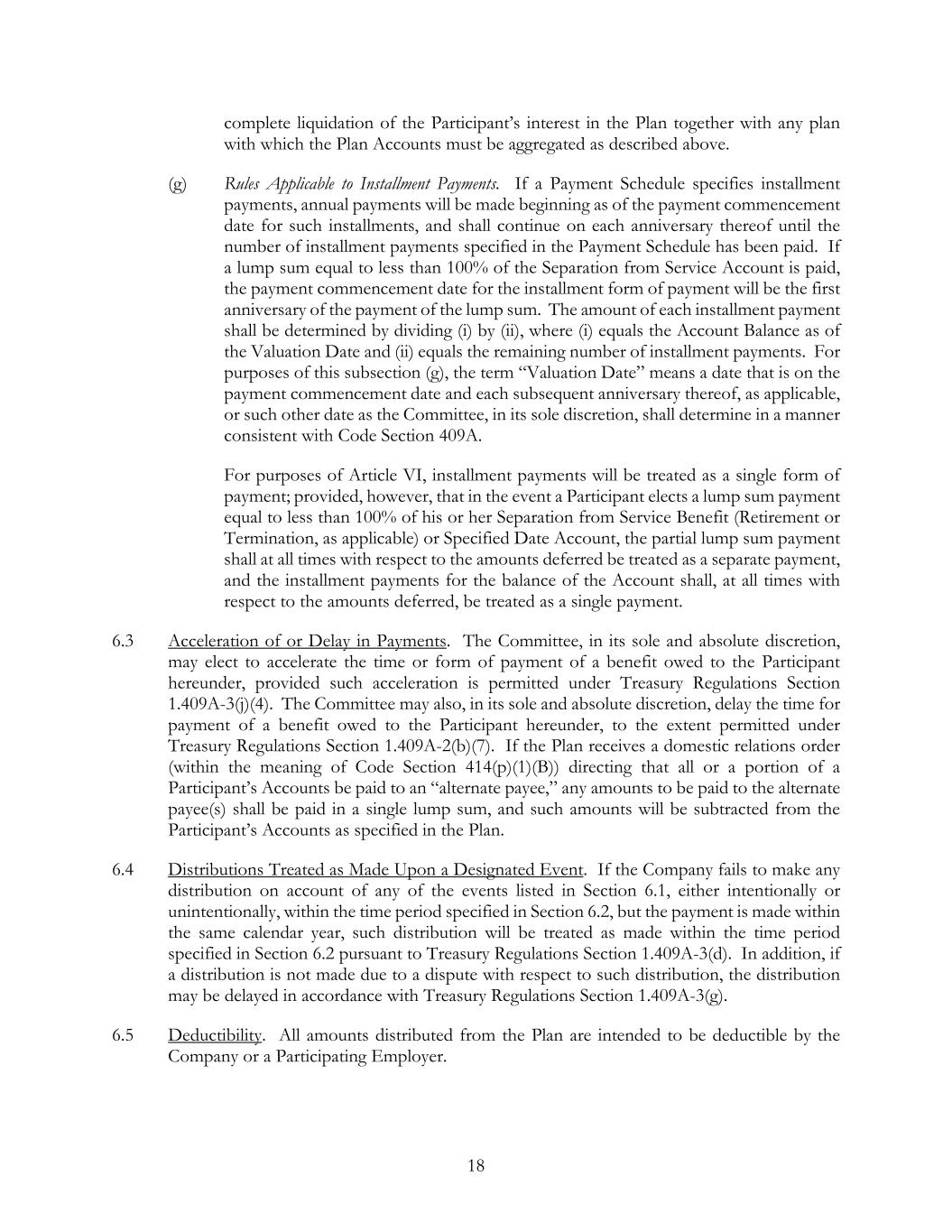
18 complete liquidation of the Participant’s interest in the Plan together with any plan with which the Plan Accounts must be aggregated as described above. (g) Rules Applicable to Installment Payments. If a Payment Schedule specifies installment payments, annual payments will be made beginning as of the payment commencement date for such installments, and shall continue on each anniversary thereof until the number of installment payments specified in the Payment Schedule has been paid. If a lump sum equal to less than 100% of the Separation from Service Account is paid, the payment commencement date for the installment form of payment will be the first anniversary of the payment of the lump sum. The amount of each installment payment shall be determined by dividing (i) by (ii), where (i) equals the Account Balance as of the Valuation Date and (ii) equals the remaining number of installment payments. For purposes of this subsection (g), the term “Valuation Date” means a date that is on the payment commencement date and each subsequent anniversary thereof, as applicable, or such other date as the Committee, in its sole discretion, shall determine in a manner consistent with Code Section 409A. For purposes of Article VI, installment payments will be treated as a single form of payment; provided, however, that in the event a Participant elects a lump sum payment equal to less than 100% of his or her Separation from Service Benefit (Retirement or Termination, as applicable) or Specified Date Account, the partial lump sum payment shall at all times with respect to the amounts deferred be treated as a separate payment, and the installment payments for the balance of the Account shall, at all times with respect to the amounts deferred, be treated as a single payment. 6.3 Acceleration of or Delay in Payments. The Committee, in its sole and absolute discretion, may elect to accelerate the time or form of payment of a benefit owed to the Participant hereunder, provided such acceleration is permitted under Treasury Regulations Section 1.409A-3(j)(4). The Committee may also, in its sole and absolute discretion, delay the time for payment of a benefit owed to the Participant hereunder, to the extent permitted under Treasury Regulations Section 1.409A-2(b)(7). If the Plan receives a domestic relations order (within the meaning of Code Section 414(p)(1)(B)) directing that all or a portion of a Participant’s Accounts be paid to an “alternate payee,” any amounts to be paid to the alternate payee(s) shall be paid in a single lump sum, and such amounts will be subtracted from the Participant’s Accounts as specified in the Plan. 6.4 Distributions Treated as Made Upon a Designated Event. If the Company fails to make any distribution on account of any of the events listed in Section 6.1, either intentionally or unintentionally, within the time period specified in Section 6.2, but the payment is made within the same calendar year, such distribution will be treated as made within the time period specified in Section 6.2 pursuant to Treasury Regulations Section 1.409A-3(d). In addition, if a distribution is not made due to a dispute with respect to such distribution, the distribution may be delayed in accordance with Treasury Regulations Section 1.409A-3(g). 6.5 Deductibility. All amounts distributed from the Plan are intended to be deductible by the Company or a Participating Employer.

19 ARTICLE VII Modifications to Payment Schedules 7.1 Participant’s Right to Modify. A Participant may modify any or all of the Payment Schedules with respect to one or more Separation from Service Benefit (e.g., to be paid at Retirement or Termination), Specified Date Benefit, Death Benefit, Change in Control Benefit or Disability Benefit, consistent with the permissible Payment Schedules available under the Plan, provided such modification complies with the requirements of this Article VII and Code Section 409A and Treas. Reg. §1.409A-2(b), and are authorized by the Committee. Modifications of Payment Schedules with respect to Accounts not explicitly identified in the immediately preceding sentence are not permissible under the Plan. 7.2 Time of Election. In the case of any modification to any Payment Schedule authorized by Section 7.1, the date on which a modification election is submitted to the Committee must be at least 12 months prior to the date on which payment of such Account is scheduled to commence under the Payment Schedule in effect prior to the modification in accordance with Treas. Reg. §1.409A-2(b)(1)(iii). 7.3 Date of Payment under Modified Payment Schedule. Except in the case of the Disability Benefit, the Death Benefit and Unforeseeable Emergency Payments, the date payments are to commence under the modified Payment Schedule must be no earlier than five years after the date payment would have commenced under the previous Payment Schedule (or, in the case of installment payments treated as a single payment, five years after the first amount was scheduled to be paid) in accordance with Treas. Reg. §1.409A-2(b)(1)(ii). Under no circumstances may a modification election result in an acceleration of payments in violation of Code Section 409A. 7.4 Effective Date. A modification election submitted in accordance with this Article VII is irrevocable upon receipt by the Committee and shall not become effective until 12 months after such date in accordance with Treas. Reg. §1.409A-2(b)(1)(i). 7.5 Effect on Accounts. An election to modify a Payment Schedule is specific to the Account or payment event to which it applies, and shall not be construed to affect the Payment Schedules of any other Accounts. ARTICLE VIII Valuation of Account Balances; Investments 8.1 Valuation. Deferrals shall be credited to appropriate Accounts on or about the date such Compensation would have been paid to the Participant absent the Compensation Deferral Agreement. Discretionary Contributions shall be credited at the time or times determined by the Committee in its sole discretion. Valuation of Accounts shall be performed under procedures approved by the Committee. 8.2 Adjustment for Earnings. Each Account will be adjusted to reflect Earnings on each Business Day. Adjustments shall reflect the net earnings, gains, losses, expenses, appreciation and depreciation associated with an investment option for each portion of the Account allocated to such option (“investment allocation”).
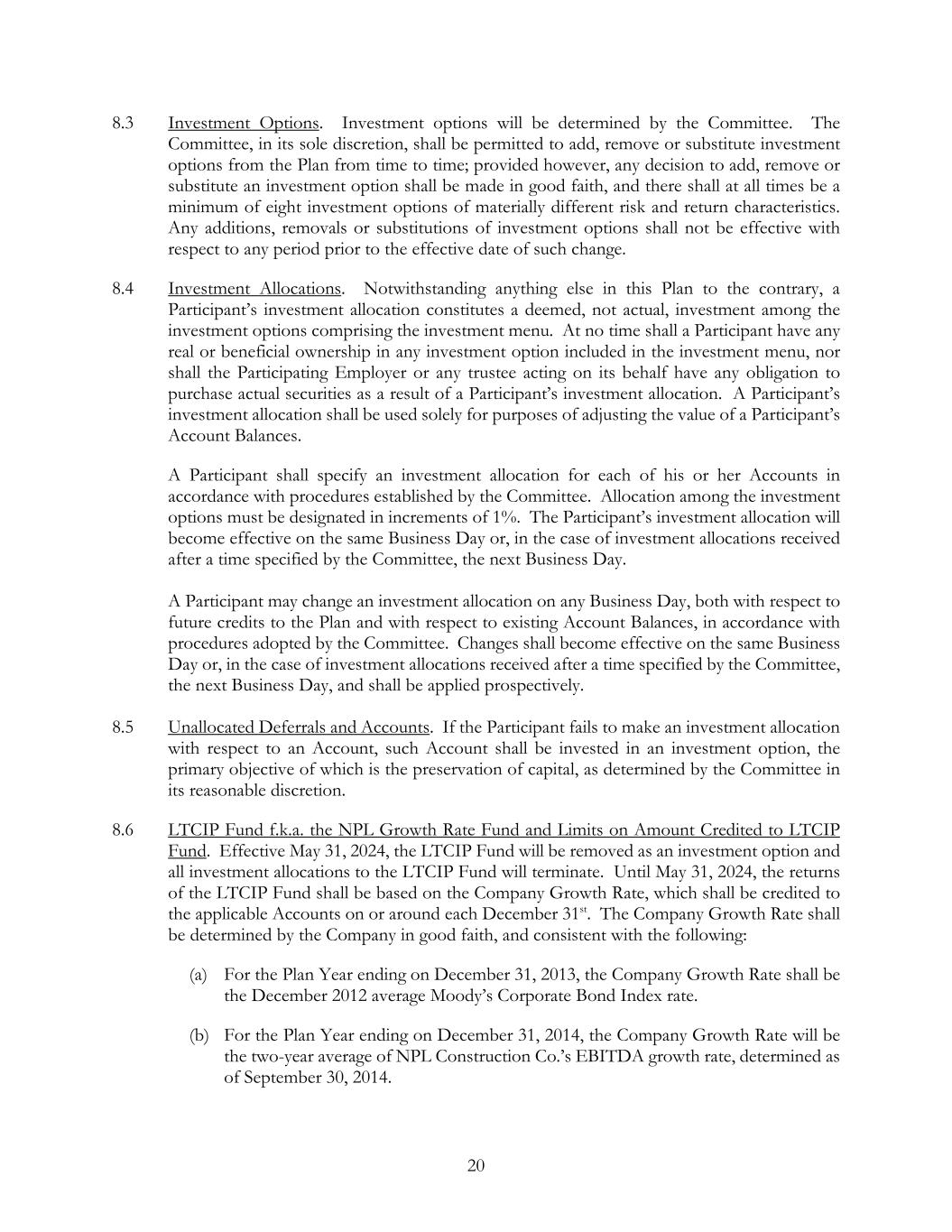
20 8.3 Investment Options. Investment options will be determined by the Committee. The Committee, in its sole discretion, shall be permitted to add, remove or substitute investment options from the Plan from time to time; provided however, any decision to add, remove or substitute an investment option shall be made in good faith, and there shall at all times be a minimum of eight investment options of materially different risk and return characteristics. Any additions, removals or substitutions of investment options shall not be effective with respect to any period prior to the effective date of such change. 8.4 Investment Allocations. Notwithstanding anything else in this Plan to the contrary, a Participant’s investment allocation constitutes a deemed, not actual, investment among the investment options comprising the investment menu. At no time shall a Participant have any real or beneficial ownership in any investment option included in the investment menu, nor shall the Participating Employer or any trustee acting on its behalf have any obligation to purchase actual securities as a result of a Participant’s investment allocation. A Participant’s investment allocation shall be used solely for purposes of adjusting the value of a Participant’s Account Balances. A Participant shall specify an investment allocation for each of his or her Accounts in accordance with procedures established by the Committee. Allocation among the investment options must be designated in increments of 1%. The Participant’s investment allocation will become effective on the same Business Day or, in the case of investment allocations received after a time specified by the Committee, the next Business Day. A Participant may change an investment allocation on any Business Day, both with respect to future credits to the Plan and with respect to existing Account Balances, in accordance with procedures adopted by the Committee. Changes shall become effective on the same Business Day or, in the case of investment allocations received after a time specified by the Committee, the next Business Day, and shall be applied prospectively. 8.5 Unallocated Deferrals and Accounts. If the Participant fails to make an investment allocation with respect to an Account, such Account shall be invested in an investment option, the primary objective of which is the preservation of capital, as determined by the Committee in its reasonable discretion. 8.6 LTCIP Fund f.k.a. the NPL Growth Rate Fund and Limits on Amount Credited to LTCIP Fund. Effective May 31, 2024, the LTCIP Fund will be removed as an investment option and all investment allocations to the LTCIP Fund will terminate. Until May 31, 2024, the returns of the LTCIP Fund shall be based on the Company Growth Rate, which shall be credited to the applicable Accounts on or around each December 31st. The Company Growth Rate shall be determined by the Company in good faith, and consistent with the following: (a) For the Plan Year ending on December 31, 2013, the Company Growth Rate shall be the December 2012 average Moody’s Corporate Bond Index rate. (b) For the Plan Year ending on December 31, 2014, the Company Growth Rate will be the two-year average of NPL Construction Co.’s EBITDA growth rate, determined as of September 30, 2014.
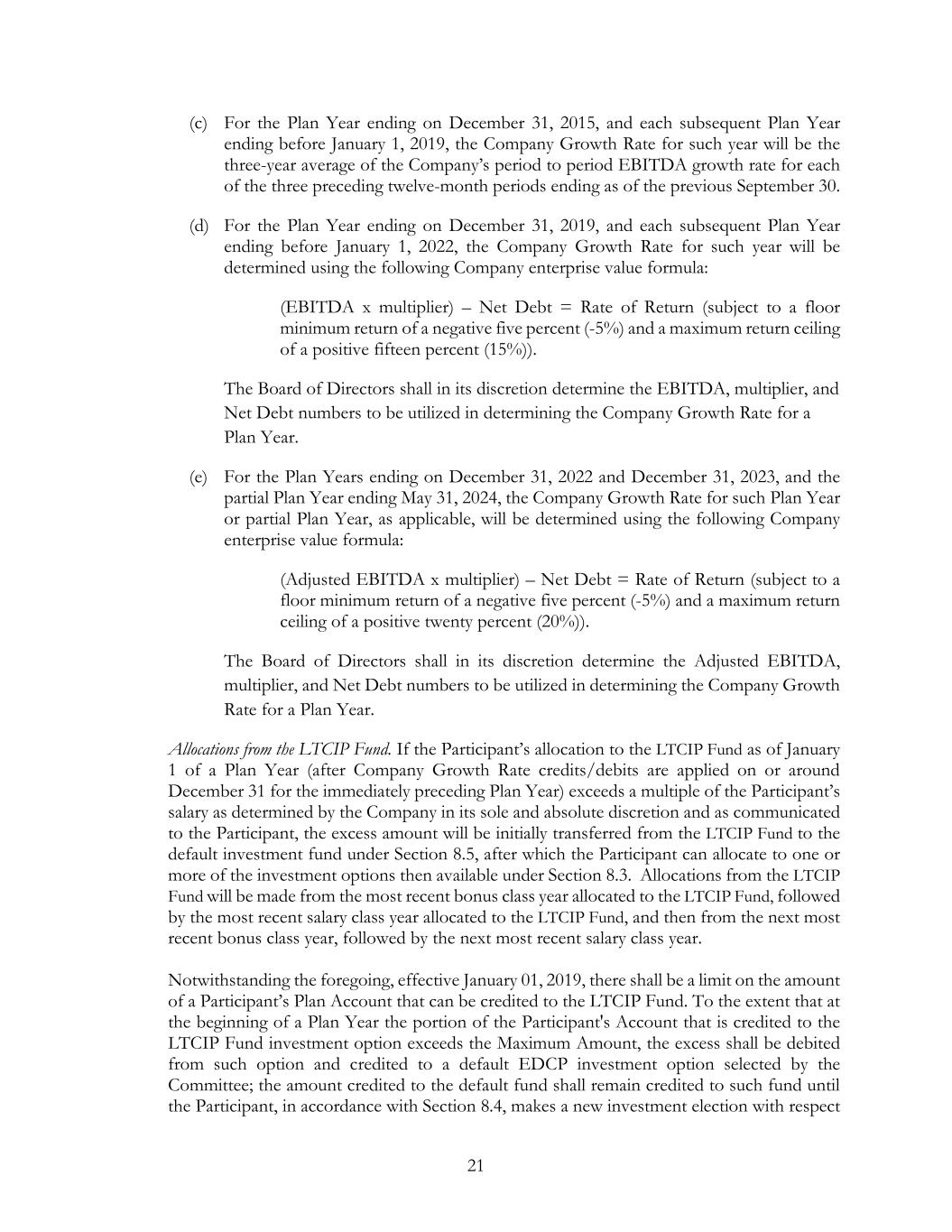
21 (c) For the Plan Year ending on December 31, 2015, and each subsequent Plan Year ending before January 1, 2019, the Company Growth Rate for such year will be the three-year average of the Company’s period to period EBITDA growth rate for each of the three preceding twelve-month periods ending as of the previous September 30. (d) For the Plan Year ending on December 31, 2019, and each subsequent Plan Year ending before January 1, 2022, the Company Growth Rate for such year will be determined using the following Company enterprise value formula: (EBITDA x multiplier) – Net Debt = Rate of Return (subject to a floor minimum return of a negative five percent (-5%) and a maximum return ceiling of a positive fifteen percent (15%)). The Board of Directors shall in its discretion determine the EBITDA, multiplier, and Net Debt numbers to be utilized in determining the Company Growth Rate for a Plan Year. (e) For the Plan Years ending on December 31, 2022 and December 31, 2023, and the partial Plan Year ending May 31, 2024, the Company Growth Rate for such Plan Year or partial Plan Year, as applicable, will be determined using the following Company enterprise value formula: (Adjusted EBITDA x multiplier) – Net Debt = Rate of Return (subject to a floor minimum return of a negative five percent (-5%) and a maximum return ceiling of a positive twenty percent (20%)). The Board of Directors shall in its discretion determine the Adjusted EBITDA, multiplier, and Net Debt numbers to be utilized in determining the Company Growth Rate for a Plan Year. Allocations from the LTCIP Fund. If the Participant’s allocation to the LTCIP Fund as of January 1 of a Plan Year (after Company Growth Rate credits/debits are applied on or around December 31 for the immediately preceding Plan Year) exceeds a multiple of the Participant’s salary as determined by the Company in its sole and absolute discretion and as communicated to the Participant, the excess amount will be initially transferred from the LTCIP Fund to the default investment fund under Section 8.5, after which the Participant can allocate to one or more of the investment options then available under Section 8.3. Allocations from the LTCIP Fund will be made from the most recent bonus class year allocated to the LTCIP Fund, followed by the most recent salary class year allocated to the LTCIP Fund, and then from the next most recent bonus class year, followed by the next most recent salary class year. Notwithstanding the foregoing, effective January 01, 2019, there shall be a limit on the amount of a Participant’s Plan Account that can be credited to the LTCIP Fund. To the extent that at the beginning of a Plan Year the portion of the Participant's Account that is credited to the LTCIP Fund investment option exceeds the Maximum Amount, the excess shall be debited from such option and credited to a default EDCP investment option selected by the Committee; the amount credited to the default fund shall remain credited to such fund until the Participant, in accordance with Section 8.4, makes a new investment election with respect
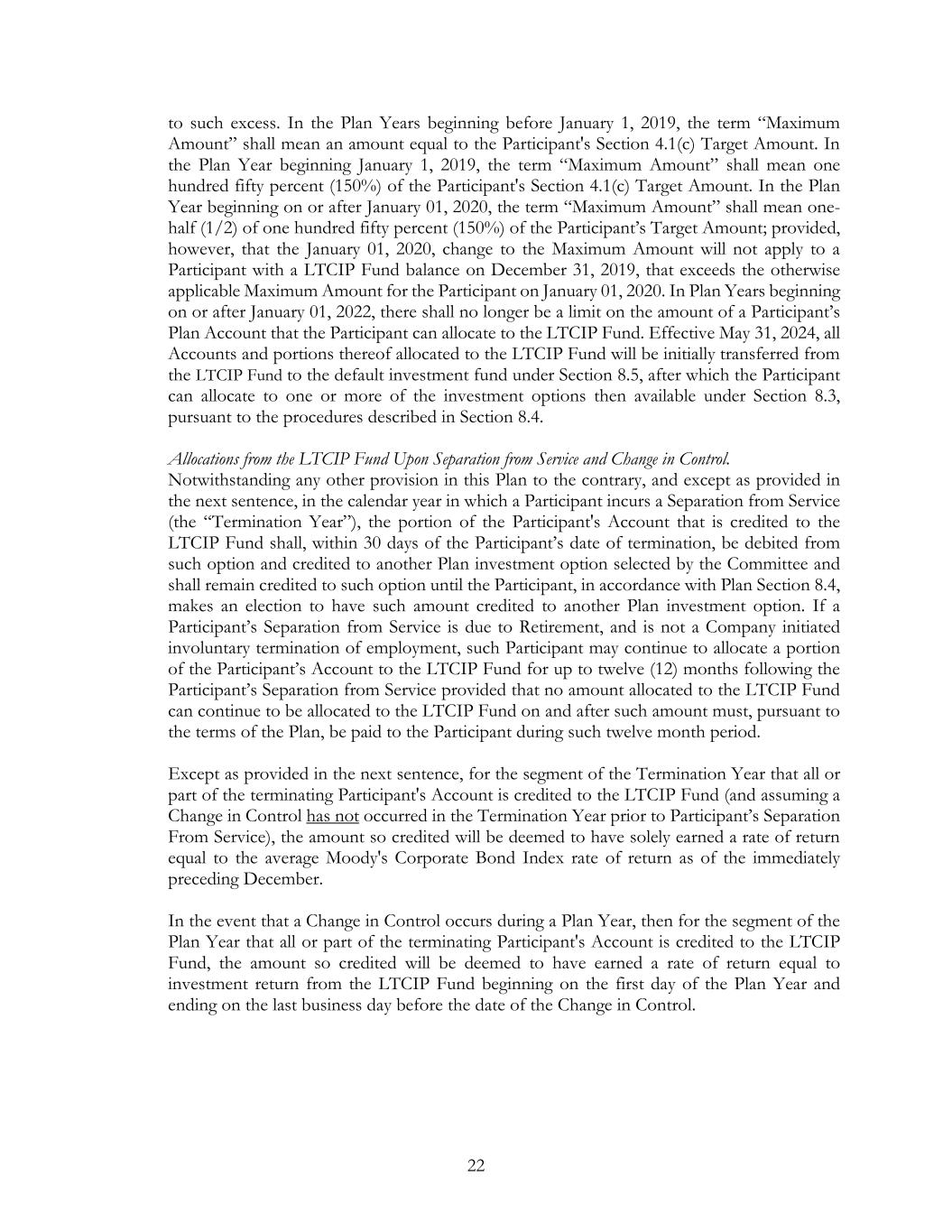
22 to such excess. In the Plan Years beginning before January 1, 2019, the term “Maximum Amount” shall mean an amount equal to the Participant's Section 4.1(c) Target Amount. In the Plan Year beginning January 1, 2019, the term “Maximum Amount” shall mean one hundred fifty percent (150%) of the Participant's Section 4.1(c) Target Amount. In the Plan Year beginning on or after January 01, 2020, the term “Maximum Amount” shall mean one- half (1/2) of one hundred fifty percent (150%) of the Participant’s Target Amount; provided, however, that the January 01, 2020, change to the Maximum Amount will not apply to a Participant with a LTCIP Fund balance on December 31, 2019, that exceeds the otherwise applicable Maximum Amount for the Participant on January 01, 2020. In Plan Years beginning on or after January 01, 2022, there shall no longer be a limit on the amount of a Participant’s Plan Account that the Participant can allocate to the LTCIP Fund. Effective May 31, 2024, all Accounts and portions thereof allocated to the LTCIP Fund will be initially transferred from the LTCIP Fund to the default investment fund under Section 8.5, after which the Participant can allocate to one or more of the investment options then available under Section 8.3, pursuant to the procedures described in Section 8.4. Allocations from the LTCIP Fund Upon Separation from Service and Change in Control. Notwithstanding any other provision in this Plan to the contrary, and except as provided in the next sentence, in the calendar year in which a Participant incurs a Separation from Service (the “Termination Year”), the portion of the Participant's Account that is credited to the LTCIP Fund shall, within 30 days of the Participant’s date of termination, be debited from such option and credited to another Plan investment option selected by the Committee and shall remain credited to such option until the Participant, in accordance with Plan Section 8.4, makes an election to have such amount credited to another Plan investment option. If a Participant’s Separation from Service is due to Retirement, and is not a Company initiated involuntary termination of employment, such Participant may continue to allocate a portion of the Participant’s Account to the LTCIP Fund for up to twelve (12) months following the Participant’s Separation from Service provided that no amount allocated to the LTCIP Fund can continue to be allocated to the LTCIP Fund on and after such amount must, pursuant to the terms of the Plan, be paid to the Participant during such twelve month period. Except as provided in the next sentence, for the segment of the Termination Year that all or part of the terminating Participant's Account is credited to the LTCIP Fund (and assuming a Change in Control has not occurred in the Termination Year prior to Participant’s Separation From Service), the amount so credited will be deemed to have solely earned a rate of return equal to the average Moody's Corporate Bond Index rate of return as of the immediately preceding December. In the event that a Change in Control occurs during a Plan Year, then for the segment of the Plan Year that all or part of the terminating Participant's Account is credited to the LTCIP Fund, the amount so credited will be deemed to have earned a rate of return equal to investment return from the LTCIP Fund beginning on the first day of the Plan Year and ending on the last business day before the date of the Change in Control.
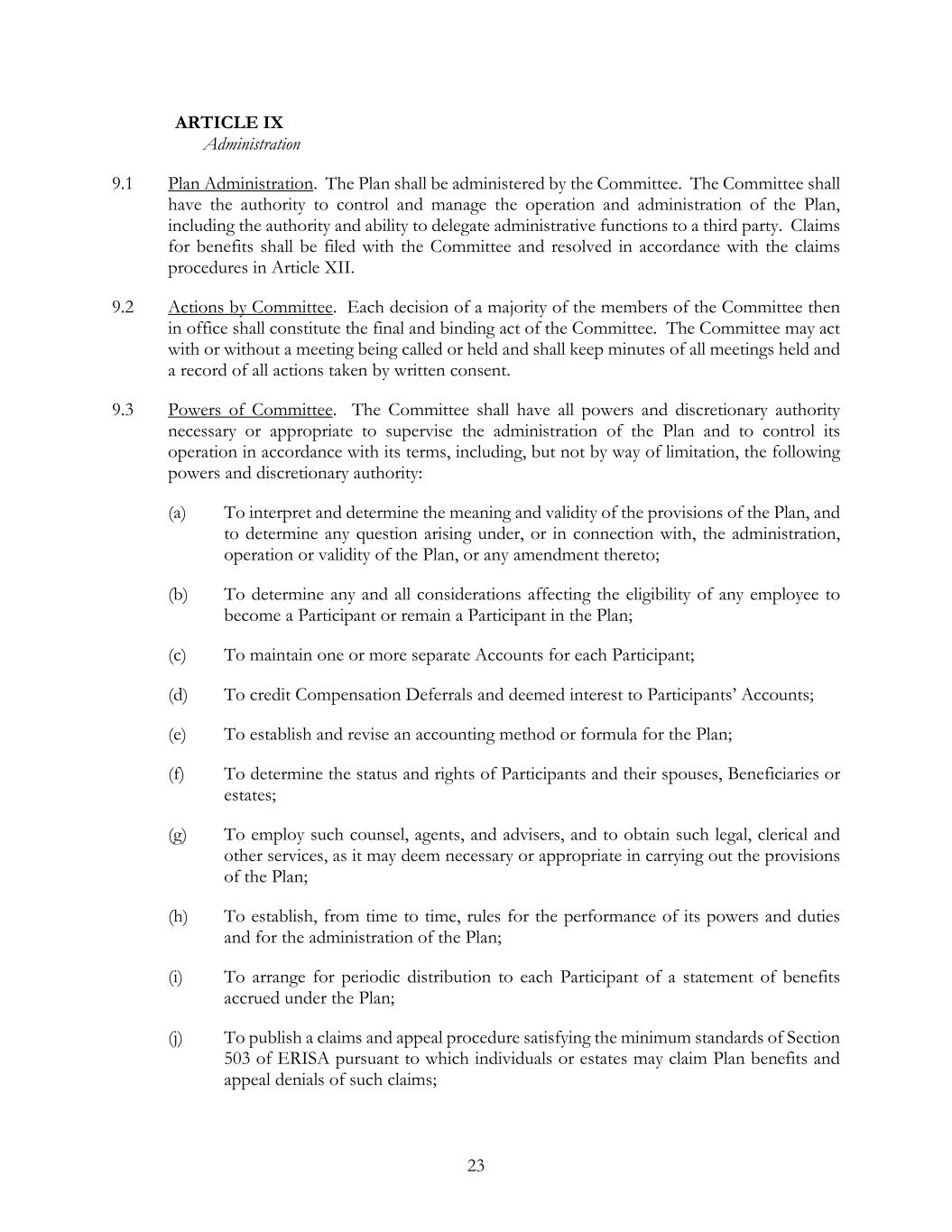
23 ARTICLE IX Administration 9.1 Plan Administration. The Plan shall be administered by the Committee. The Committee shall have the authority to control and manage the operation and administration of the Plan, including the authority and ability to delegate administrative functions to a third party. Claims for benefits shall be filed with the Committee and resolved in accordance with the claims procedures in Article XII. 9.2 Actions by Committee. Each decision of a majority of the members of the Committee then in office shall constitute the final and binding act of the Committee. The Committee may act with or without a meeting being called or held and shall keep minutes of all meetings held and a record of all actions taken by written consent. 9.3 Powers of Committee. The Committee shall have all powers and discretionary authority necessary or appropriate to supervise the administration of the Plan and to control its operation in accordance with its terms, including, but not by way of limitation, the following powers and discretionary authority: (a) To interpret and determine the meaning and validity of the provisions of the Plan, and to determine any question arising under, or in connection with, the administration, operation or validity of the Plan, or any amendment thereto; (b) To determine any and all considerations affecting the eligibility of any employee to become a Participant or remain a Participant in the Plan; (c) To maintain one or more separate Accounts for each Participant; (d) To credit Compensation Deferrals and deemed interest to Participants’ Accounts; (e) To establish and revise an accounting method or formula for the Plan; (f) To determine the status and rights of Participants and their spouses, Beneficiaries or estates; (g) To employ such counsel, agents, and advisers, and to obtain such legal, clerical and other services, as it may deem necessary or appropriate in carrying out the provisions of the Plan; (h) To establish, from time to time, rules for the performance of its powers and duties and for the administration of the Plan; (i) To arrange for periodic distribution to each Participant of a statement of benefits accrued under the Plan; (j) To publish a claims and appeal procedure satisfying the minimum standards of Section 503 of ERISA pursuant to which individuals or estates may claim Plan benefits and appeal denials of such claims;
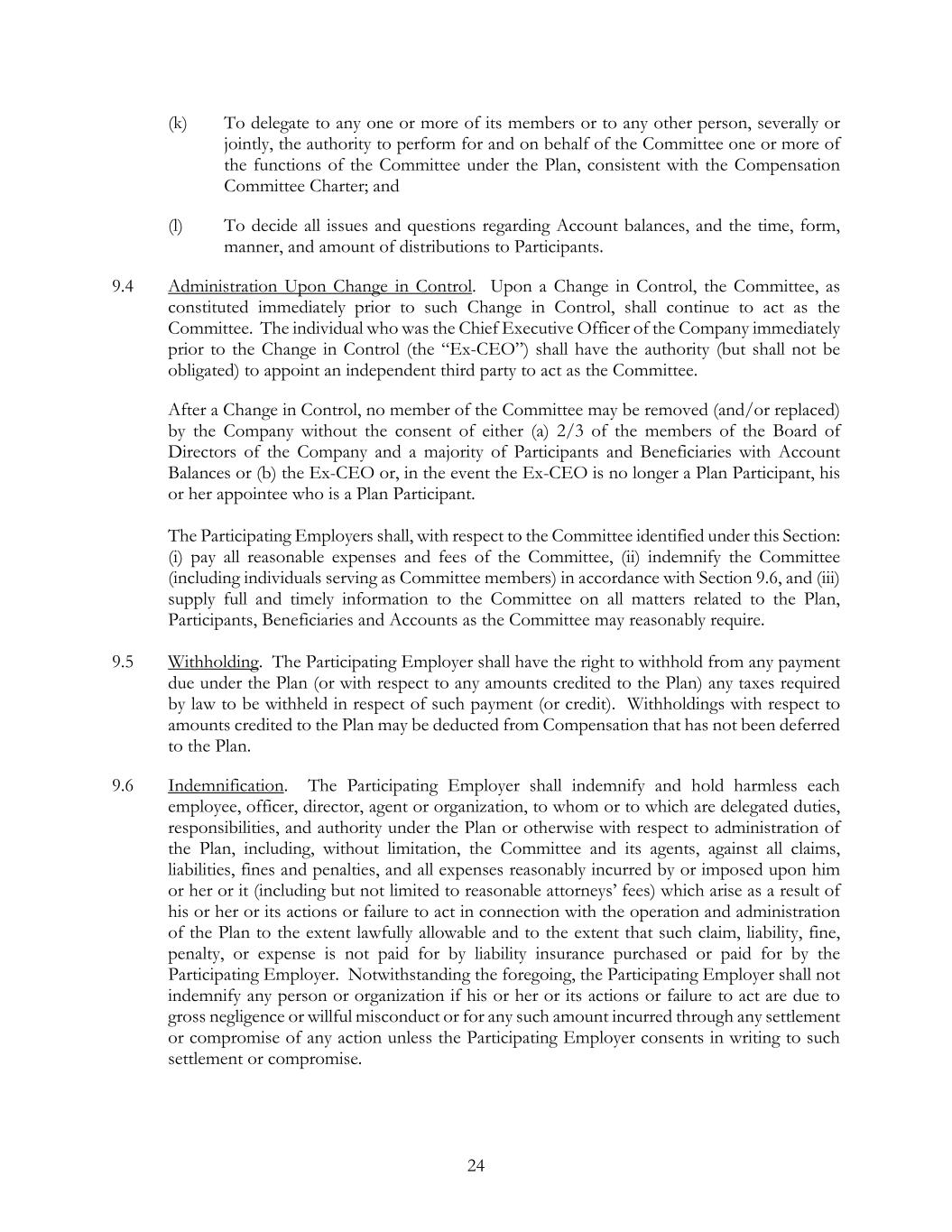
24 (k) To delegate to any one or more of its members or to any other person, severally or jointly, the authority to perform for and on behalf of the Committee one or more of the functions of the Committee under the Plan, consistent with the Compensation Committee Charter; and (l) To decide all issues and questions regarding Account balances, and the time, form, manner, and amount of distributions to Participants. 9.4 Administration Upon Change in Control. Upon a Change in Control, the Committee, as constituted immediately prior to such Change in Control, shall continue to act as the Committee. The individual who was the Chief Executive Officer of the Company immediately prior to the Change in Control (the “Ex-CEO”) shall have the authority (but shall not be obligated) to appoint an independent third party to act as the Committee. After a Change in Control, no member of the Committee may be removed (and/or replaced) by the Company without the consent of either (a) 2/3 of the members of the Board of Directors of the Company and a majority of Participants and Beneficiaries with Account Balances or (b) the Ex-CEO or, in the event the Ex-CEO is no longer a Plan Participant, his or her appointee who is a Plan Participant. The Participating Employers shall, with respect to the Committee identified under this Section: (i) pay all reasonable expenses and fees of the Committee, (ii) indemnify the Committee (including individuals serving as Committee members) in accordance with Section 9.6, and (iii) supply full and timely information to the Committee on all matters related to the Plan, Participants, Beneficiaries and Accounts as the Committee may reasonably require. 9.5 Withholding. The Participating Employer shall have the right to withhold from any payment due under the Plan (or with respect to any amounts credited to the Plan) any taxes required by law to be withheld in respect of such payment (or credit). Withholdings with respect to amounts credited to the Plan may be deducted from Compensation that has not been deferred to the Plan. 9.6 Indemnification. The Participating Employer shall indemnify and hold harmless each employee, officer, director, agent or organization, to whom or to which are delegated duties, responsibilities, and authority under the Plan or otherwise with respect to administration of the Plan, including, without limitation, the Committee and its agents, against all claims, liabilities, fines and penalties, and all expenses reasonably incurred by or imposed upon him or her or it (including but not limited to reasonable attorneys’ fees) which arise as a result of his or her or its actions or failure to act in connection with the operation and administration of the Plan to the extent lawfully allowable and to the extent that such claim, liability, fine, penalty, or expense is not paid for by liability insurance purchased or paid for by the Participating Employer. Notwithstanding the foregoing, the Participating Employer shall not indemnify any person or organization if his or her or its actions or failure to act are due to gross negligence or willful misconduct or for any such amount incurred through any settlement or compromise of any action unless the Participating Employer consents in writing to such settlement or compromise.
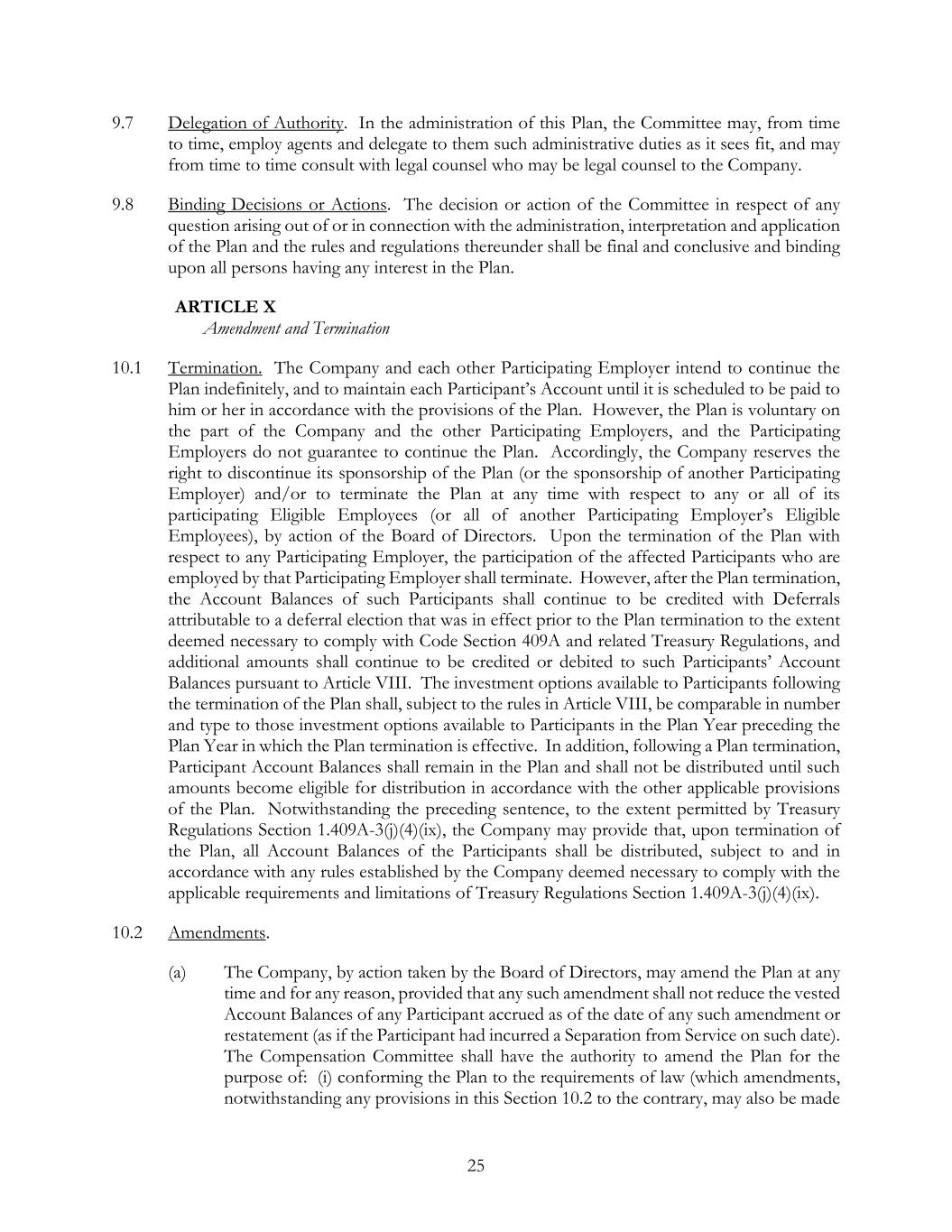
25 9.7 Delegation of Authority. In the administration of this Plan, the Committee may, from time to time, employ agents and delegate to them such administrative duties as it sees fit, and may from time to time consult with legal counsel who may be legal counsel to the Company. 9.8 Binding Decisions or Actions. The decision or action of the Committee in respect of any question arising out of or in connection with the administration, interpretation and application of the Plan and the rules and regulations thereunder shall be final and conclusive and binding upon all persons having any interest in the Plan. ARTICLE X Amendment and Termination 10.1 Termination. The Company and each other Participating Employer intend to continue the Plan indefinitely, and to maintain each Participant’s Account until it is scheduled to be paid to him or her in accordance with the provisions of the Plan. However, the Plan is voluntary on the part of the Company and the other Participating Employers, and the Participating Employers do not guarantee to continue the Plan. Accordingly, the Company reserves the right to discontinue its sponsorship of the Plan (or the sponsorship of another Participating Employer) and/or to terminate the Plan at any time with respect to any or all of its participating Eligible Employees (or all of another Participating Employer’s Eligible Employees), by action of the Board of Directors. Upon the termination of the Plan with respect to any Participating Employer, the participation of the affected Participants who are employed by that Participating Employer shall terminate. However, after the Plan termination, the Account Balances of such Participants shall continue to be credited with Deferrals attributable to a deferral election that was in effect prior to the Plan termination to the extent deemed necessary to comply with Code Section 409A and related Treasury Regulations, and additional amounts shall continue to be credited or debited to such Participants’ Account Balances pursuant to Article VIII. The investment options available to Participants following the termination of the Plan shall, subject to the rules in Article VIII, be comparable in number and type to those investment options available to Participants in the Plan Year preceding the Plan Year in which the Plan termination is effective. In addition, following a Plan termination, Participant Account Balances shall remain in the Plan and shall not be distributed until such amounts become eligible for distribution in accordance with the other applicable provisions of the Plan. Notwithstanding the preceding sentence, to the extent permitted by Treasury Regulations Section 1.409A-3(j)(4)(ix), the Company may provide that, upon termination of the Plan, all Account Balances of the Participants shall be distributed, subject to and in accordance with any rules established by the Company deemed necessary to comply with the applicable requirements and limitations of Treasury Regulations Section 1.409A-3(j)(4)(ix). 10.2 Amendments. (a) The Company, by action taken by the Board of Directors, may amend the Plan at any time and for any reason, provided that any such amendment shall not reduce the vested Account Balances of any Participant accrued as of the date of any such amendment or restatement (as if the Participant had incurred a Separation from Service on such date). The Compensation Committee shall have the authority to amend the Plan for the purpose of: (i) conforming the Plan to the requirements of law (which amendments, notwithstanding any provisions in this Section 10.2 to the contrary, may also be made
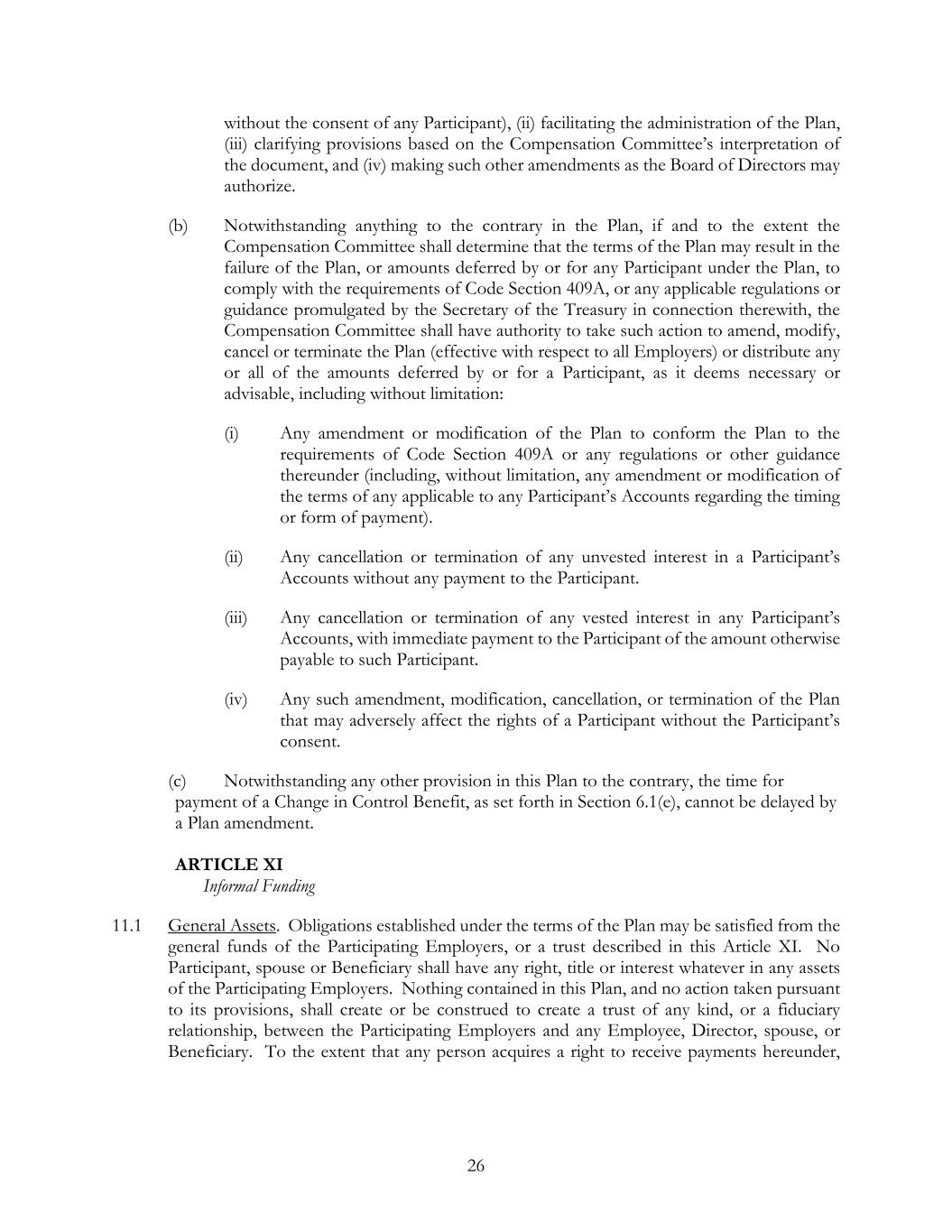
26 without the consent of any Participant), (ii) facilitating the administration of the Plan, (iii) clarifying provisions based on the Compensation Committee’s interpretation of the document, and (iv) making such other amendments as the Board of Directors may authorize. (b) Notwithstanding anything to the contrary in the Plan, if and to the extent the Compensation Committee shall determine that the terms of the Plan may result in the failure of the Plan, or amounts deferred by or for any Participant under the Plan, to comply with the requirements of Code Section 409A, or any applicable regulations or guidance promulgated by the Secretary of the Treasury in connection therewith, the Compensation Committee shall have authority to take such action to amend, modify, cancel or terminate the Plan (effective with respect to all Employers) or distribute any or all of the amounts deferred by or for a Participant, as it deems necessary or advisable, including without limitation: (i) Any amendment or modification of the Plan to conform the Plan to the requirements of Code Section 409A or any regulations or other guidance thereunder (including, without limitation, any amendment or modification of the terms of any applicable to any Participant’s Accounts regarding the timing or form of payment). (ii) Any cancellation or termination of any unvested interest in a Participant’s Accounts without any payment to the Participant. (iii) Any cancellation or termination of any vested interest in any Participant’s Accounts, with immediate payment to the Participant of the amount otherwise payable to such Participant. (iv) Any such amendment, modification, cancellation, or termination of the Plan that may adversely affect the rights of a Participant without the Participant’s consent. (c) Notwithstanding any other provision in this Plan to the contrary, the time for payment of a Change in Control Benefit, as set forth in Section 6.1(e), cannot be delayed by a Plan amendment. ARTICLE XI Informal Funding 11.1 General Assets. Obligations established under the terms of the Plan may be satisfied from the general funds of the Participating Employers, or a trust described in this Article XI. No Participant, spouse or Beneficiary shall have any right, title or interest whatever in any assets of the Participating Employers. Nothing contained in this Plan, and no action taken pursuant to its provisions, shall create or be construed to create a trust of any kind, or a fiduciary relationship, between the Participating Employers and any Employee, Director, spouse, or Beneficiary. To the extent that any person acquires a right to receive payments hereunder,
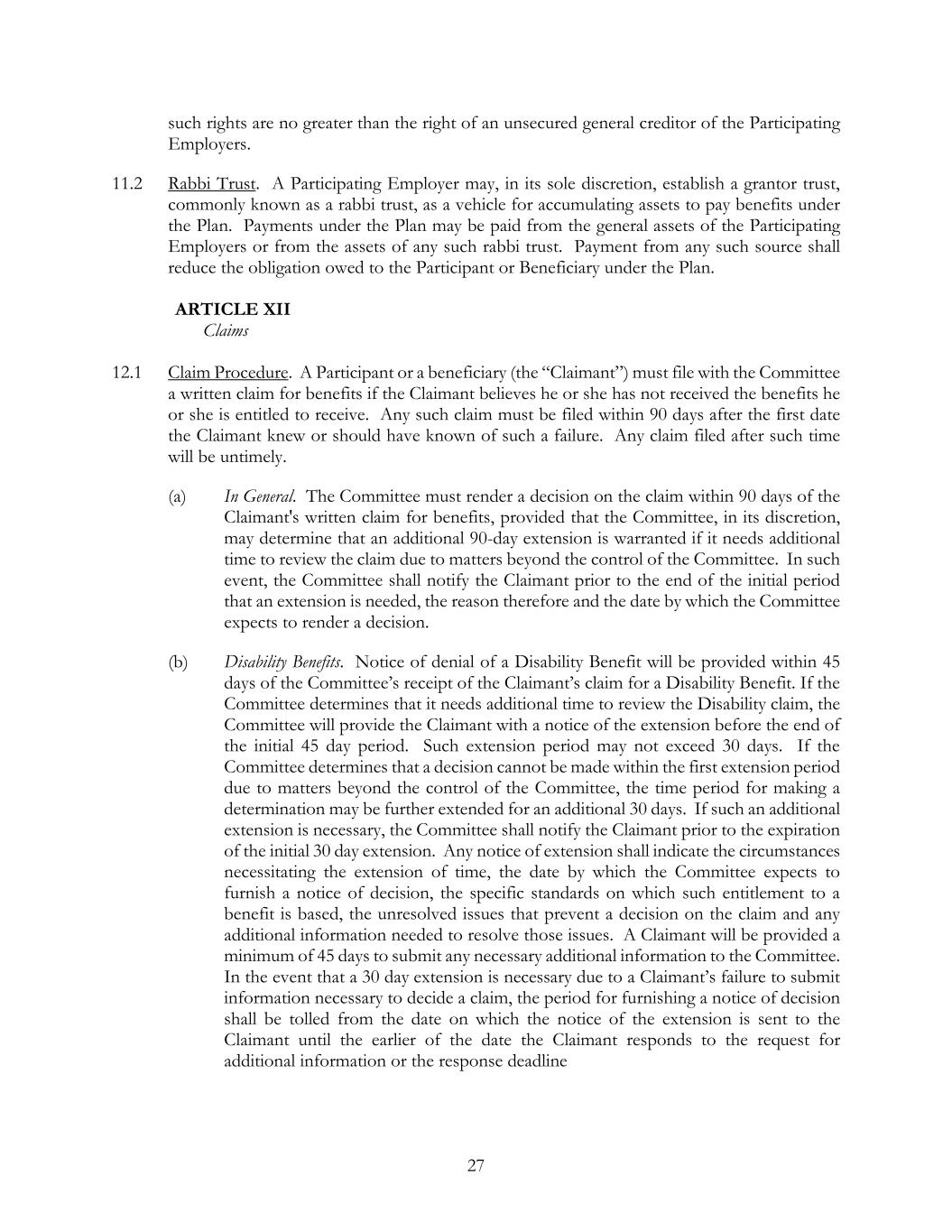
27 such rights are no greater than the right of an unsecured general creditor of the Participating Employers. 11.2 Rabbi Trust. A Participating Employer may, in its sole discretion, establish a grantor trust, commonly known as a rabbi trust, as a vehicle for accumulating assets to pay benefits under the Plan. Payments under the Plan may be paid from the general assets of the Participating Employers or from the assets of any such rabbi trust. Payment from any such source shall reduce the obligation owed to the Participant or Beneficiary under the Plan. ARTICLE XII Claims 12.1 Claim Procedure. A Participant or a beneficiary (the “Claimant”) must file with the Committee a written claim for benefits if the Claimant believes he or she has not received the benefits he or she is entitled to receive. Any such claim must be filed within 90 days after the first date the Claimant knew or should have known of such a failure. Any claim filed after such time will be untimely. (a) In General. The Committee must render a decision on the claim within 90 days of the Claimant's written claim for benefits, provided that the Committee, in its discretion, may determine that an additional 90-day extension is warranted if it needs additional time to review the claim due to matters beyond the control of the Committee. In such event, the Committee shall notify the Claimant prior to the end of the initial period that an extension is needed, the reason therefore and the date by which the Committee expects to render a decision. (b) Disability Benefits. Notice of denial of a Disability Benefit will be provided within 45 days of the Committee’s receipt of the Claimant’s claim for a Disability Benefit. If the Committee determines that it needs additional time to review the Disability claim, the Committee will provide the Claimant with a notice of the extension before the end of the initial 45 day period. Such extension period may not exceed 30 days. If the Committee determines that a decision cannot be made within the first extension period due to matters beyond the control of the Committee, the time period for making a determination may be further extended for an additional 30 days. If such an additional extension is necessary, the Committee shall notify the Claimant prior to the expiration of the initial 30 day extension. Any notice of extension shall indicate the circumstances necessitating the extension of time, the date by which the Committee expects to furnish a notice of decision, the specific standards on which such entitlement to a benefit is based, the unresolved issues that prevent a decision on the claim and any additional information needed to resolve those issues. A Claimant will be provided a minimum of 45 days to submit any necessary additional information to the Committee. In the event that a 30 day extension is necessary due to a Claimant’s failure to submit information necessary to decide a claim, the period for furnishing a notice of decision shall be tolled from the date on which the notice of the extension is sent to the Claimant until the earlier of the date the Claimant responds to the request for additional information or the response deadline
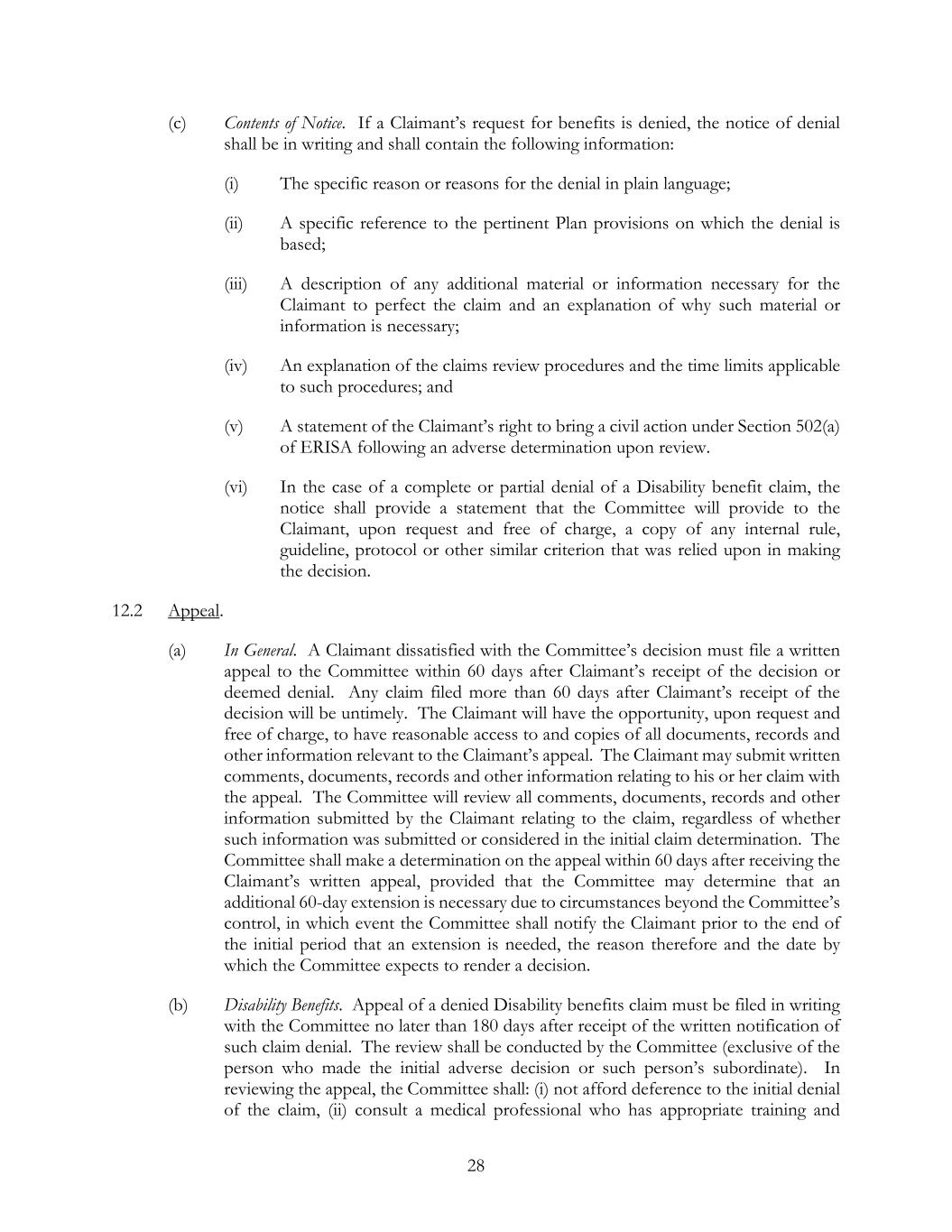
28 (c) Contents of Notice. If a Claimant’s request for benefits is denied, the notice of denial shall be in writing and shall contain the following information: (i) The specific reason or reasons for the denial in plain language; (ii) A specific reference to the pertinent Plan provisions on which the denial is based; (iii) A description of any additional material or information necessary for the Claimant to perfect the claim and an explanation of why such material or information is necessary; (iv) An explanation of the claims review procedures and the time limits applicable to such procedures; and (v) A statement of the Claimant’s right to bring a civil action under Section 502(a) of ERISA following an adverse determination upon review. (vi) In the case of a complete or partial denial of a Disability benefit claim, the notice shall provide a statement that the Committee will provide to the Claimant, upon request and free of charge, a copy of any internal rule, guideline, protocol or other similar criterion that was relied upon in making the decision. 12.2 Appeal. (a) In General. A Claimant dissatisfied with the Committee’s decision must file a written appeal to the Committee within 60 days after Claimant’s receipt of the decision or deemed denial. Any claim filed more than 60 days after Claimant’s receipt of the decision will be untimely. The Claimant will have the opportunity, upon request and free of charge, to have reasonable access to and copies of all documents, records and other information relevant to the Claimant’s appeal. The Claimant may submit written comments, documents, records and other information relating to his or her claim with the appeal. The Committee will review all comments, documents, records and other information submitted by the Claimant relating to the claim, regardless of whether such information was submitted or considered in the initial claim determination. The Committee shall make a determination on the appeal within 60 days after receiving the Claimant’s written appeal, provided that the Committee may determine that an additional 60-day extension is necessary due to circumstances beyond the Committee’s control, in which event the Committee shall notify the Claimant prior to the end of the initial period that an extension is needed, the reason therefore and the date by which the Committee expects to render a decision. (b) Disability Benefits. Appeal of a denied Disability benefits claim must be filed in writing with the Committee no later than 180 days after receipt of the written notification of such claim denial. The review shall be conducted by the Committee (exclusive of the person who made the initial adverse decision or such person’s subordinate). In reviewing the appeal, the Committee shall: (i) not afford deference to the initial denial of the claim, (ii) consult a medical professional who has appropriate training and
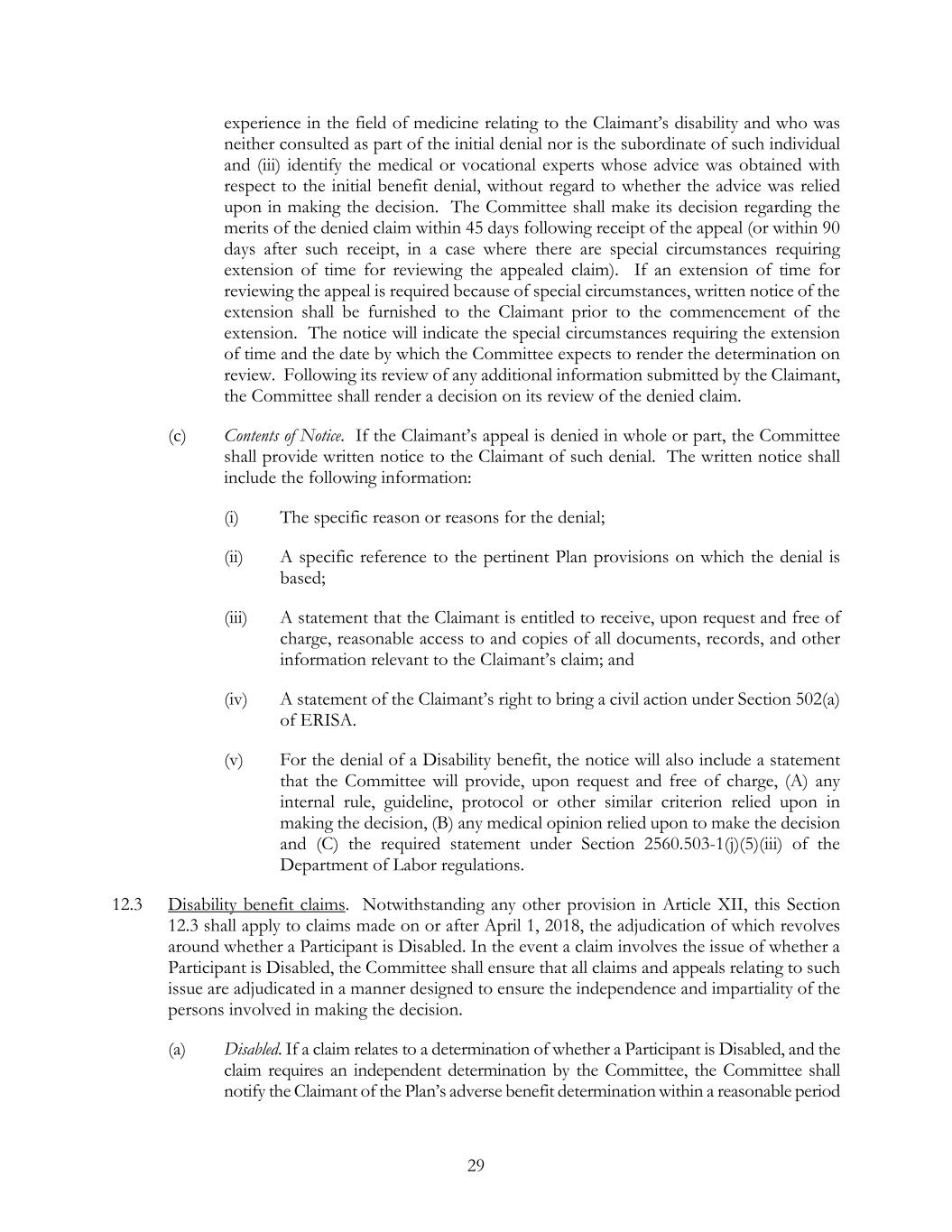
29 experience in the field of medicine relating to the Claimant’s disability and who was neither consulted as part of the initial denial nor is the subordinate of such individual and (iii) identify the medical or vocational experts whose advice was obtained with respect to the initial benefit denial, without regard to whether the advice was relied upon in making the decision. The Committee shall make its decision regarding the merits of the denied claim within 45 days following receipt of the appeal (or within 90 days after such receipt, in a case where there are special circumstances requiring extension of time for reviewing the appealed claim). If an extension of time for reviewing the appeal is required because of special circumstances, written notice of the extension shall be furnished to the Claimant prior to the commencement of the extension. The notice will indicate the special circumstances requiring the extension of time and the date by which the Committee expects to render the determination on review. Following its review of any additional information submitted by the Claimant, the Committee shall render a decision on its review of the denied claim. (c) Contents of Notice. If the Claimant’s appeal is denied in whole or part, the Committee shall provide written notice to the Claimant of such denial. The written notice shall include the following information: (i) The specific reason or reasons for the denial; (ii) A specific reference to the pertinent Plan provisions on which the denial is based; (iii) A statement that the Claimant is entitled to receive, upon request and free of charge, reasonable access to and copies of all documents, records, and other information relevant to the Claimant’s claim; and (iv) A statement of the Claimant’s right to bring a civil action under Section 502(a) of ERISA. (v) For the denial of a Disability benefit, the notice will also include a statement that the Committee will provide, upon request and free of charge, (A) any internal rule, guideline, protocol or other similar criterion relied upon in making the decision, (B) any medical opinion relied upon to make the decision and (C) the required statement under Section 2560.503-1(j)(5)(iii) of the Department of Labor regulations. 12.3 Disability benefit claims. Notwithstanding any other provision in Article XII, this Section 12.3 shall apply to claims made on or after April 1, 2018, the adjudication of which revolves around whether a Participant is Disabled. In the event a claim involves the issue of whether a Participant is Disabled, the Committee shall ensure that all claims and appeals relating to such issue are adjudicated in a manner designed to ensure the independence and impartiality of the persons involved in making the decision. (a) Disabled. If a claim relates to a determination of whether a Participant is Disabled, and the claim requires an independent determination by the Committee, the Committee shall notify the Claimant of the Plan’s adverse benefit determination within a reasonable period
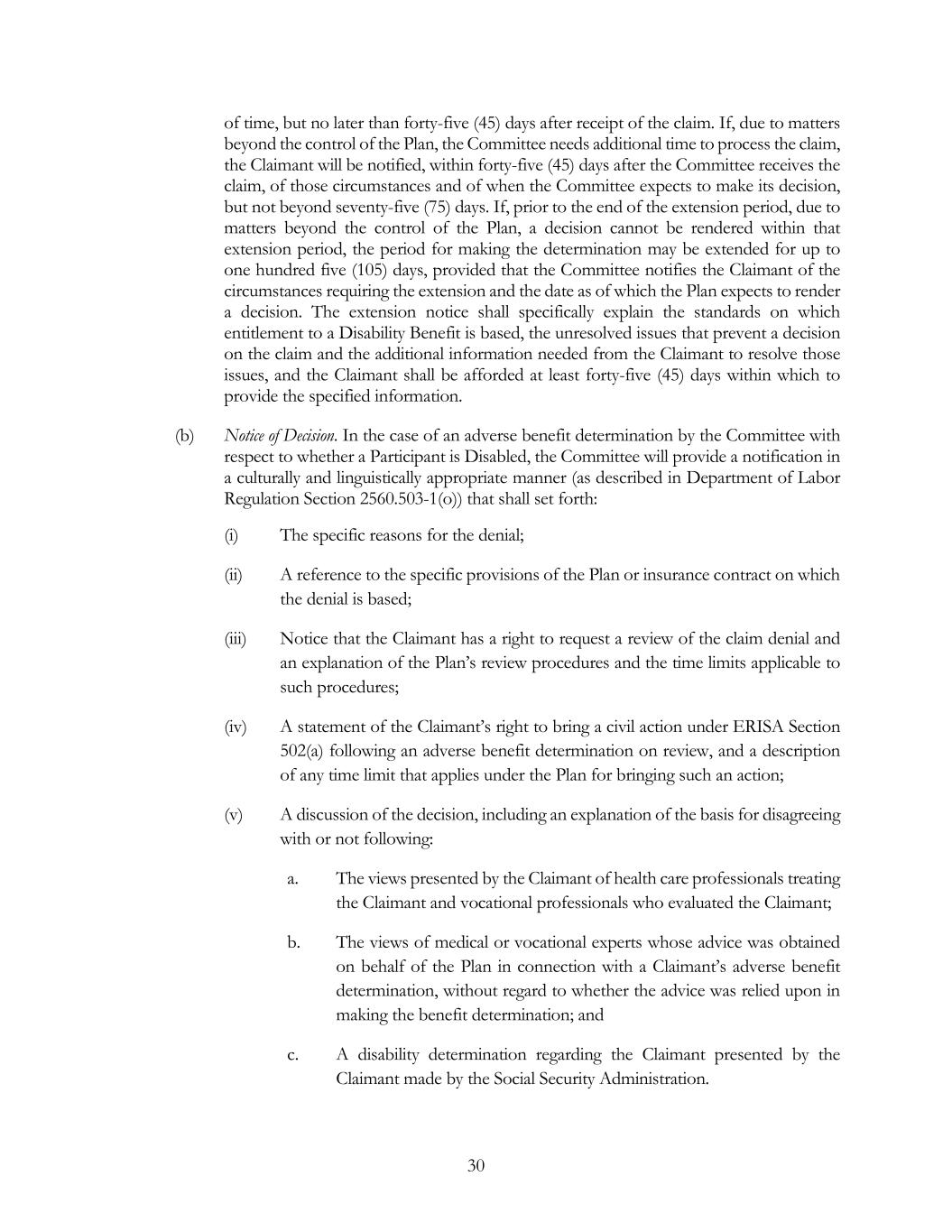
30 of time, but no later than forty-five (45) days after receipt of the claim. If, due to matters beyond the control of the Plan, the Committee needs additional time to process the claim, the Claimant will be notified, within forty-five (45) days after the Committee receives the claim, of those circumstances and of when the Committee expects to make its decision, but not beyond seventy-five (75) days. If, prior to the end of the extension period, due to matters beyond the control of the Plan, a decision cannot be rendered within that extension period, the period for making the determination may be extended for up to one hundred five (105) days, provided that the Committee notifies the Claimant of the circumstances requiring the extension and the date as of which the Plan expects to render a decision. The extension notice shall specifically explain the standards on which entitlement to a Disability Benefit is based, the unresolved issues that prevent a decision on the claim and the additional information needed from the Claimant to resolve those issues, and the Claimant shall be afforded at least forty-five (45) days within which to provide the specified information. (b) Notice of Decision. In the case of an adverse benefit determination by the Committee with respect to whether a Participant is Disabled, the Committee will provide a notification in a culturally and linguistically appropriate manner (as described in Department of Labor Regulation Section 2560.503-1(o)) that shall set forth: (i) The specific reasons for the denial; (ii) A reference to the specific provisions of the Plan or insurance contract on which the denial is based; (iii) Notice that the Claimant has a right to request a review of the claim denial and an explanation of the Plan’s review procedures and the time limits applicable to such procedures; (iv) A statement of the Claimant’s right to bring a civil action under ERISA Section 502(a) following an adverse benefit determination on review, and a description of any time limit that applies under the Plan for bringing such an action; (v) A discussion of the decision, including an explanation of the basis for disagreeing with or not following: a. The views presented by the Claimant of health care professionals treating the Claimant and vocational professionals who evaluated the Claimant; b. The views of medical or vocational experts whose advice was obtained on behalf of the Plan in connection with a Claimant’s adverse benefit determination, without regard to whether the advice was relied upon in making the benefit determination; and c. A disability determination regarding the Claimant presented by the Claimant made by the Social Security Administration.
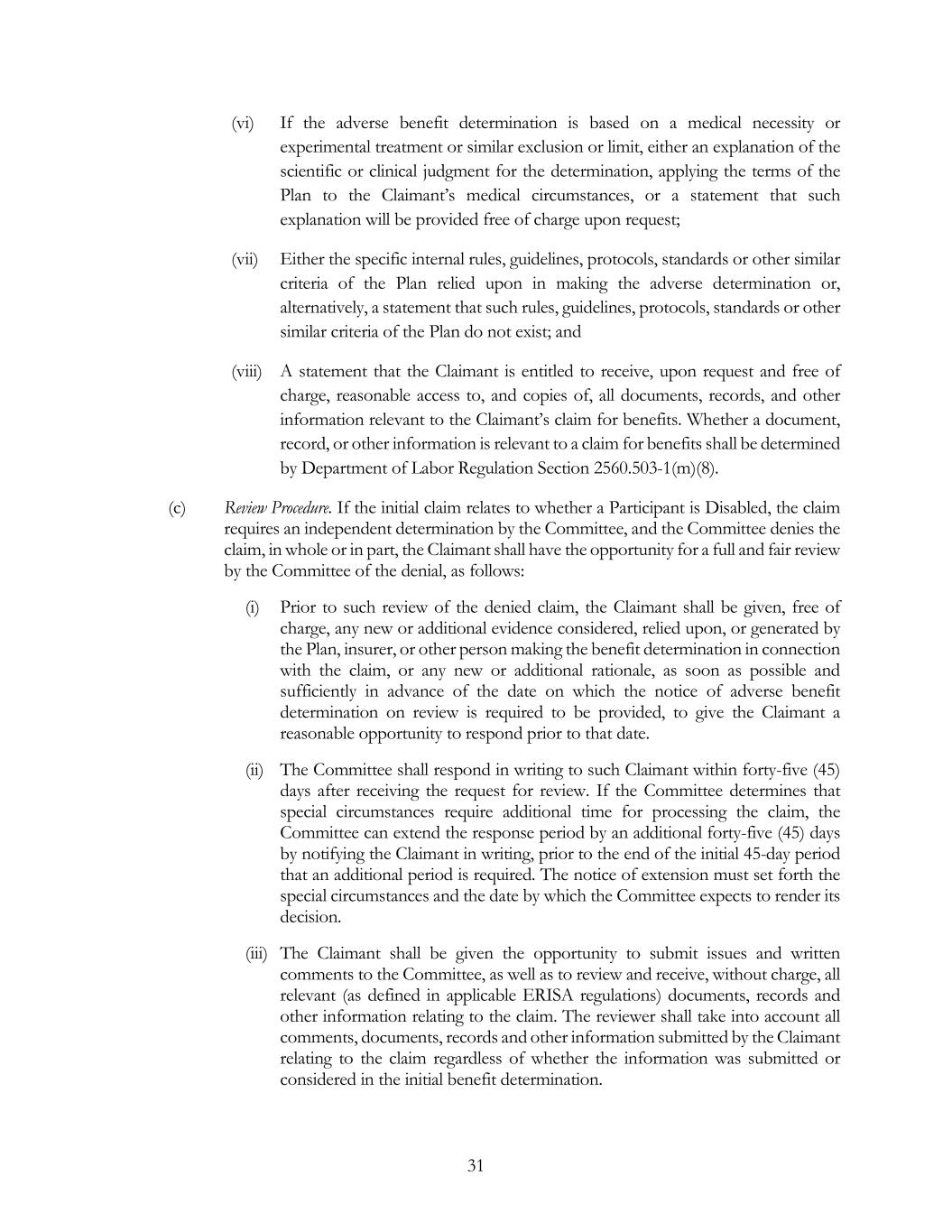
31 (vi) If the adverse benefit determination is based on a medical necessity or experimental treatment or similar exclusion or limit, either an explanation of the scientific or clinical judgment for the determination, applying the terms of the Plan to the Claimant’s medical circumstances, or a statement that such explanation will be provided free of charge upon request; (vii) Either the specific internal rules, guidelines, protocols, standards or other similar criteria of the Plan relied upon in making the adverse determination or, alternatively, a statement that such rules, guidelines, protocols, standards or other similar criteria of the Plan do not exist; and (viii) A statement that the Claimant is entitled to receive, upon request and free of charge, reasonable access to, and copies of, all documents, records, and other information relevant to the Claimant’s claim for benefits. Whether a document, record, or other information is relevant to a claim for benefits shall be determined by Department of Labor Regulation Section 2560.503-1(m)(8). (c) Review Procedure. If the initial claim relates to whether a Participant is Disabled, the claim requires an independent determination by the Committee, and the Committee denies the claim, in whole or in part, the Claimant shall have the opportunity for a full and fair review by the Committee of the denial, as follows: (i) Prior to such review of the denied claim, the Claimant shall be given, free of charge, any new or additional evidence considered, relied upon, or generated by the Plan, insurer, or other person making the benefit determination in connection with the claim, or any new or additional rationale, as soon as possible and sufficiently in advance of the date on which the notice of adverse benefit determination on review is required to be provided, to give the Claimant a reasonable opportunity to respond prior to that date. (ii) The Committee shall respond in writing to such Claimant within forty-five (45) days after receiving the request for review. If the Committee determines that special circumstances require additional time for processing the claim, the Committee can extend the response period by an additional forty-five (45) days by notifying the Claimant in writing, prior to the end of the initial 45-day period that an additional period is required. The notice of extension must set forth the special circumstances and the date by which the Committee expects to render its decision. (iii) The Claimant shall be given the opportunity to submit issues and written comments to the Committee, as well as to review and receive, without charge, all relevant (as defined in applicable ERISA regulations) documents, records and other information relating to the claim. The reviewer shall take into account all comments, documents, records and other information submitted by the Claimant relating to the claim regardless of whether the information was submitted or considered in the initial benefit determination.
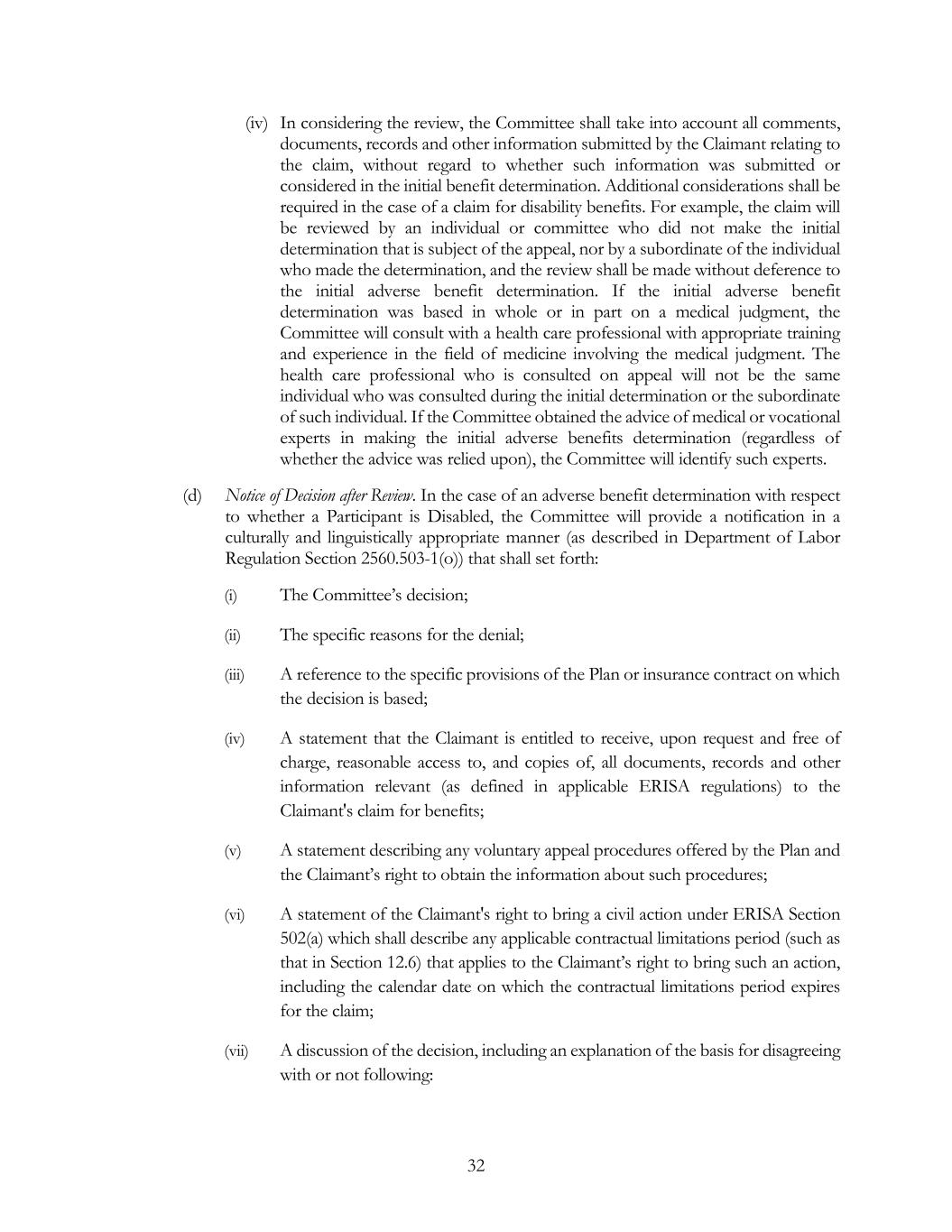
32 (iv) In considering the review, the Committee shall take into account all comments, documents, records and other information submitted by the Claimant relating to the claim, without regard to whether such information was submitted or considered in the initial benefit determination. Additional considerations shall be required in the case of a claim for disability benefits. For example, the claim will be reviewed by an individual or committee who did not make the initial determination that is subject of the appeal, nor by a subordinate of the individual who made the determination, and the review shall be made without deference to the initial adverse benefit determination. If the initial adverse benefit determination was based in whole or in part on a medical judgment, the Committee will consult with a health care professional with appropriate training and experience in the field of medicine involving the medical judgment. The health care professional who is consulted on appeal will not be the same individual who was consulted during the initial determination or the subordinate of such individual. If the Committee obtained the advice of medical or vocational experts in making the initial adverse benefits determination (regardless of whether the advice was relied upon), the Committee will identify such experts. (d) Notice of Decision after Review. In the case of an adverse benefit determination with respect to whether a Participant is Disabled, the Committee will provide a notification in a culturally and linguistically appropriate manner (as described in Department of Labor Regulation Section 2560.503-1(o)) that shall set forth: (i) The Committee’s decision; (ii) The specific reasons for the denial; (iii) A reference to the specific provisions of the Plan or insurance contract on which the decision is based; (iv) A statement that the Claimant is entitled to receive, upon request and free of charge, reasonable access to, and copies of, all documents, records and other information relevant (as defined in applicable ERISA regulations) to the Claimant's claim for benefits; (v) A statement describing any voluntary appeal procedures offered by the Plan and the Claimant’s right to obtain the information about such procedures; (vi) A statement of the Claimant's right to bring a civil action under ERISA Section 502(a) which shall describe any applicable contractual limitations period (such as that in Section 12.6) that applies to the Claimant’s right to bring such an action, including the calendar date on which the contractual limitations period expires for the claim; (vii) A discussion of the decision, including an explanation of the basis for disagreeing with or not following:

33 a. The views presented by the Claimant of health care professionals treating the Claimant and vocational professionals who evaluated the Claimant; b. The views of medical or vocational experts whose advice was obtained on behalf of the Plan in connection with a Claimant’s adverse benefit determination, without regard to whether the advice was relied upon in making the benefit determination; and c. A disability determination regarding the Claimant presented by the Claimant made by the Social Security Administration. (viii) If the adverse benefit determination is based on a medical necessity or experimental treatment or similar exclusion or limit, either an explanation of the scientific or clinical judgment for the determination, applying the terms of the Plan to the Claimant’s medical circumstances, or a statement that such explanation will be provided free of charge upon request; and (ix) Either the specific internal rules, guidelines, protocols, standards or other similar criteria of the Plan relied upon in making the adverse determination or, alternatively, a statement that such rules, guidelines, protocols, standards or other similar criteria of the Plan do not exist. (e) Exhaustion of Remedies. A Claimant must follow the claims review procedures under this Plan and exhaust his or her administrative remedies before taking any further action with respect to a claim for benefits. (f) Failure of Plan to Follow Procedures. In the case of a claim with respect to whether a Participant is Disabled, if the Plan fails to strictly adhere to all the requirements of this claims procedure with respect to whether a Participant is Disabled, the Claimant is deemed to have exhausted the administrative remedies available under the Plan, and shall be entitled to pursue any available remedies under ERISA Section 502(a) on the basis that the Plan has failed to provide a reasonable claims procedure that would yield a decision on the merits of the claim, except where the violation was: (i) de minimis; (ii) non-prejudicial; (iii) attributable to good cause or matters beyond the Plan’s control; (iv) in the context of an ongoing good-faith exchange of information; and (v) not reflective of a pattern or practice of non- compliance. The Claimant may request a written explanation of the violation from the Plan, and the Plan must provide such explanation within ten (10) days, including a specific description of its basis, if any, for asserting that the violation should not cause the administrative remedies to be deemed exhausted. If a court rejects the Claimant’s request for immediate review on the basis that the Plan met the standards for the exception, the claim shall be considered as re-filed on appeal upon the Plan’s receipt of the decision of the court. Within a reasonable time after the receipt of the decision, the Plan shall provide the claimant with notice of the resubmission. 12.4 Relevance. For purposes of Section 12.1, Section 12.2, and 12.3, documents, records, or other information shall be considered “relevant” to a Claimant’s claim for benefits if such documents, records or other information:

34 (a) Were relied upon in making the benefit determination; (b) Were submitted, considered, or generated in the course of making the benefit determination, without regard to whether such documents, records or other information were relied upon in making the benefit determination; or (c) Demonstrate compliance with the administrative processes and safeguards required pursuant to Section 12.1, Section 12.2. and Section 12.3 regarding the making of the benefit determination. 12.5 Claims Appeals Upon Change in Control. For purposes of this Article XII, upon a Change in Control, the Committee, as constituted immediately prior to such Change in Control, shall continue to act as the Committee. After a Change in Control, no member of the Committee may be removed (and/or replaced) by the Company without the consent of either (a) 2/3 of the members of the Board of Directors of the Company and a majority of Participants and Beneficiaries with Account Balances or (b) the Ex-CEO or, in the event the Ex-CEO is no longer a Plan Participant, his or her appointee who is a Plan Participant. 12.6 Constructive Denial. If the Claimant does not receive a written decision within the time period(s) described above, the claim shall be deemed denied on the last day of such period(s). 12.7 Six Month Deadline for Filing Suit. No Claimant may institute any action or proceeding in any state or federal court of law or equity, or before any administrative tribunal or arbitrator, for a claim for benefits under the Plan until he first has exhausted the procedures set forth in Sections 12.1, 12.2 and 12.3. A claimant dissatisfied with the Committee’s decision upon appeal under Sections 12.2 or 12.3 must file any lawsuit challenging that decision no later than six months after the Committee mails the notice of denial or a constructive denial occurs. Any suit brought more than six months after the denial on appeal or constructive denial shall be deemed untimely. In ruling on any timely-filed suit, the Court shall uphold the Committee’s determinations unless they constitute an abuse of discretion or fraud. 12.8 Decisions of Committee. All actions, interpretations, and decisions of the Committee shall be conclusive and binding on all persons, and shall be given the maximum deference permitted by law. 12.9 Administrative Expenses. All expenses incurred in the administration of the Plan by the Committee, or otherwise, including legal fees and expenses, shall be paid and borne by the Participating Employers. 12.10 Eligibility to Participate. No member of the Committee who also is an Eligible Employee shall be excluded from participating in the Plan, but as a member of the Committee, he or she shall not be entitled to act or pass upon any matters pertaining specifically to his or her own Account. 12.11 Indemnification. Each of the Participating Employers shall, and hereby does, indemnify and hold harmless the members of the Committee, from and against any and all losses, claims, damages or liabilities (including attorneys’ fees and amounts paid, with the approval of the Board of Directors, in settlement of any claim) arising out of or resulting from the implementation of a duty, act or decision with respect to the Plan, so long as such duty, act or
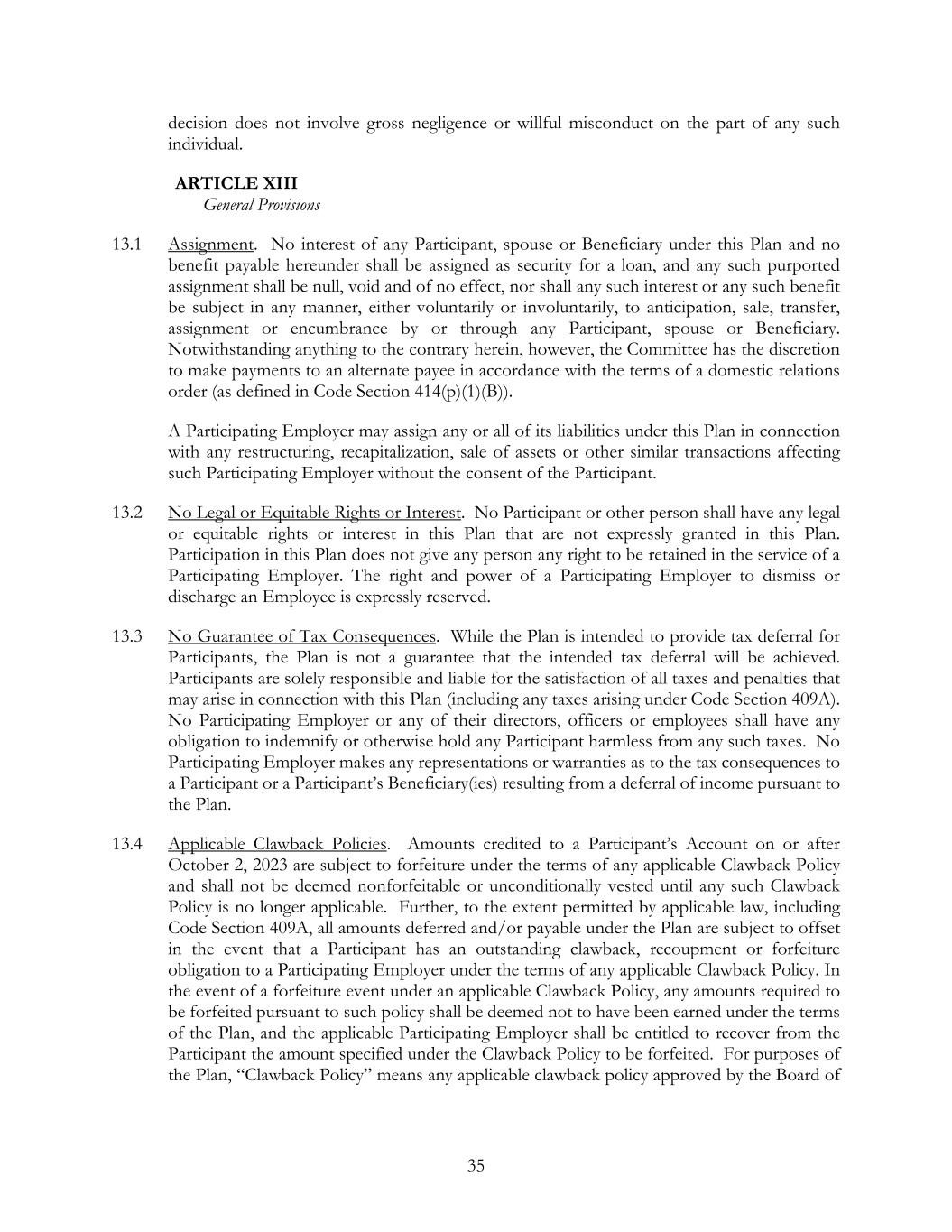
35 decision does not involve gross negligence or willful misconduct on the part of any such individual. ARTICLE XIII General Provisions 13.1 Assignment. No interest of any Participant, spouse or Beneficiary under this Plan and no benefit payable hereunder shall be assigned as security for a loan, and any such purported assignment shall be null, void and of no effect, nor shall any such interest or any such benefit be subject in any manner, either voluntarily or involuntarily, to anticipation, sale, transfer, assignment or encumbrance by or through any Participant, spouse or Beneficiary. Notwithstanding anything to the contrary herein, however, the Committee has the discretion to make payments to an alternate payee in accordance with the terms of a domestic relations order (as defined in Code Section 414(p)(1)(B)). A Participating Employer may assign any or all of its liabilities under this Plan in connection with any restructuring, recapitalization, sale of assets or other similar transactions affecting such Participating Employer without the consent of the Participant. 13.2 No Legal or Equitable Rights or Interest. No Participant or other person shall have any legal or equitable rights or interest in this Plan that are not expressly granted in this Plan. Participation in this Plan does not give any person any right to be retained in the service of a Participating Employer. The right and power of a Participating Employer to dismiss or discharge an Employee is expressly reserved. 13.3 No Guarantee of Tax Consequences. While the Plan is intended to provide tax deferral for Participants, the Plan is not a guarantee that the intended tax deferral will be achieved. Participants are solely responsible and liable for the satisfaction of all taxes and penalties that may arise in connection with this Plan (including any taxes arising under Code Section 409A). No Participating Employer or any of their directors, officers or employees shall have any obligation to indemnify or otherwise hold any Participant harmless from any such taxes. No Participating Employer makes any representations or warranties as to the tax consequences to a Participant or a Participant’s Beneficiary(ies) resulting from a deferral of income pursuant to the Plan. 13.4 Applicable Clawback Policies. Amounts credited to a Participant’s Account on or after October 2, 2023 are subject to forfeiture under the terms of any applicable Clawback Policy and shall not be deemed nonforfeitable or unconditionally vested until any such Clawback Policy is no longer applicable. Further, to the extent permitted by applicable law, including Code Section 409A, all amounts deferred and/or payable under the Plan are subject to offset in the event that a Participant has an outstanding clawback, recoupment or forfeiture obligation to a Participating Employer under the terms of any applicable Clawback Policy. In the event of a forfeiture event under an applicable Clawback Policy, any amounts required to be forfeited pursuant to such policy shall be deemed not to have been earned under the terms of the Plan, and the applicable Participating Employer shall be entitled to recover from the Participant the amount specified under the Clawback Policy to be forfeited. For purposes of the Plan, “Clawback Policy” means any applicable clawback policy approved by the Board of
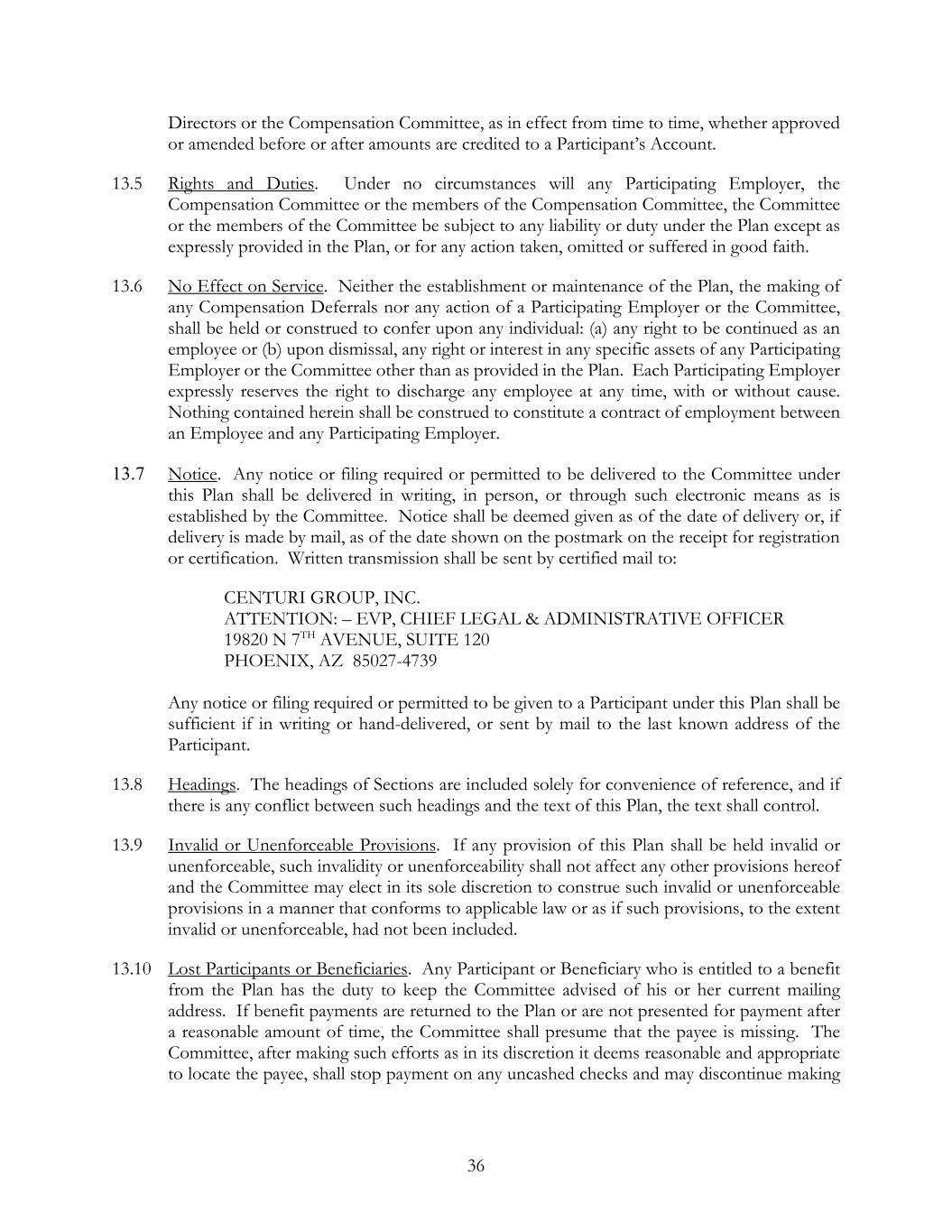
36 Directors or the Compensation Committee, as in effect from time to time, whether approved or amended before or after amounts are credited to a Participant’s Account. 13.5 Rights and Duties. Under no circumstances will any Participating Employer, the Compensation Committee or the members of the Compensation Committee, the Committee or the members of the Committee be subject to any liability or duty under the Plan except as expressly provided in the Plan, or for any action taken, omitted or suffered in good faith. 13.6 No Effect on Service. Neither the establishment or maintenance of the Plan, the making of any Compensation Deferrals nor any action of a Participating Employer or the Committee, shall be held or construed to confer upon any individual: (a) any right to be continued as an employee or (b) upon dismissal, any right or interest in any specific assets of any Participating Employer or the Committee other than as provided in the Plan. Each Participating Employer expressly reserves the right to discharge any employee at any time, with or without cause. Nothing contained herein shall be construed to constitute a contract of employment between an Employee and any Participating Employer. 13.7 Notice. Any notice or filing required or permitted to be delivered to the Committee under this Plan shall be delivered in writing, in person, or through such electronic means as is established by the Committee. Notice shall be deemed given as of the date of delivery or, if delivery is made by mail, as of the date shown on the postmark on the receipt for registration or certification. Written transmission shall be sent by certified mail to: CENTURI GROUP, INC. ATTENTION: – EVP, CHIEF LEGAL & ADMINISTRATIVE OFFICER 19820 N 7TH AVENUE, SUITE 120 PHOENIX, AZ 85027-4739 Any notice or filing required or permitted to be given to a Participant under this Plan shall be sufficient if in writing or hand-delivered, or sent by mail to the last known address of the Participant. 13.8 Headings. The headings of Sections are included solely for convenience of reference, and if there is any conflict between such headings and the text of this Plan, the text shall control. 13.9 Invalid or Unenforceable Provisions. If any provision of this Plan shall be held invalid or unenforceable, such invalidity or unenforceability shall not affect any other provisions hereof and the Committee may elect in its sole discretion to construe such invalid or unenforceable provisions in a manner that conforms to applicable law or as if such provisions, to the extent invalid or unenforceable, had not been included. 13.10 Lost Participants or Beneficiaries. Any Participant or Beneficiary who is entitled to a benefit from the Plan has the duty to keep the Committee advised of his or her current mailing address. If benefit payments are returned to the Plan or are not presented for payment after a reasonable amount of time, the Committee shall presume that the payee is missing. The Committee, after making such efforts as in its discretion it deems reasonable and appropriate to locate the payee, shall stop payment on any uncashed checks and may discontinue making
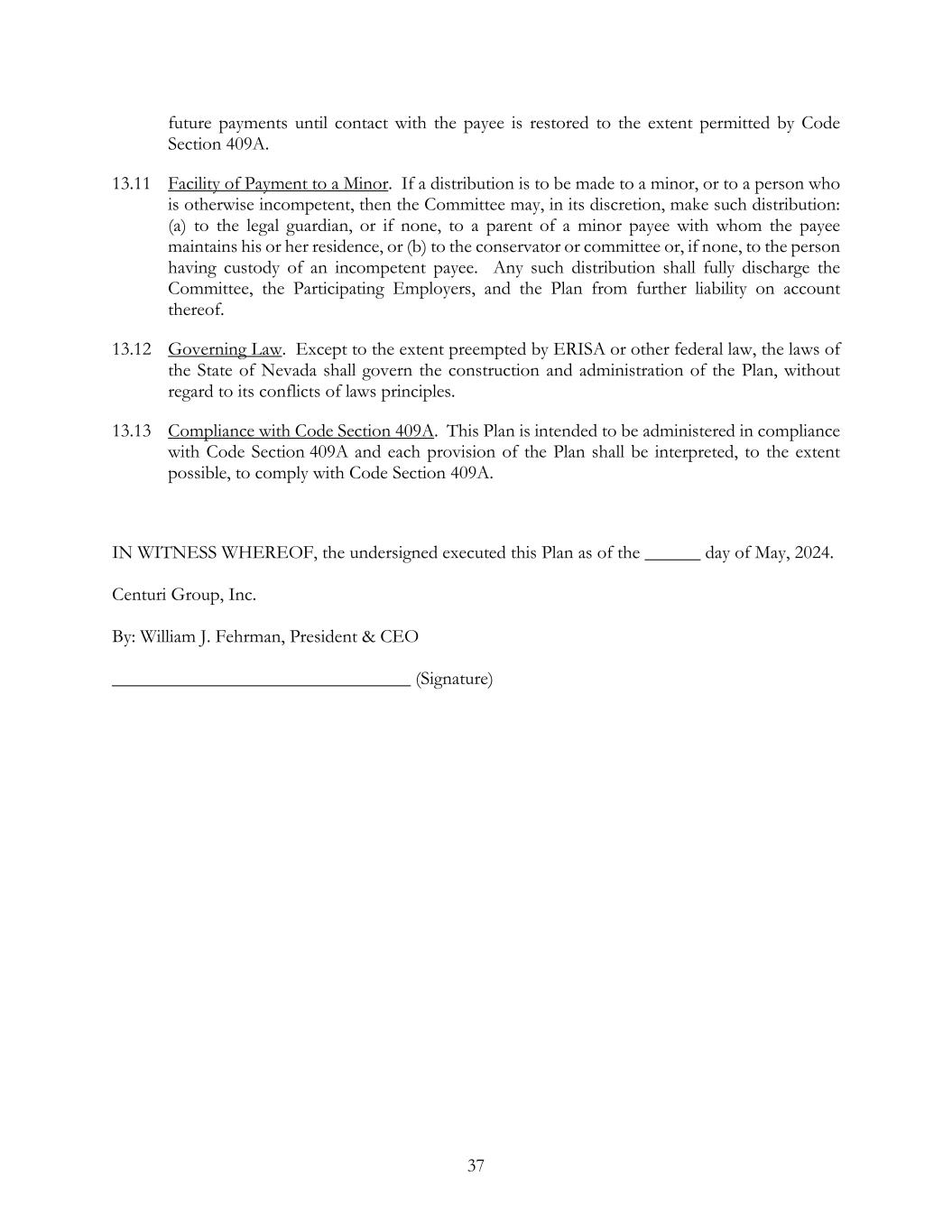
37 future payments until contact with the payee is restored to the extent permitted by Code Section 409A. 13.11 Facility of Payment to a Minor. If a distribution is to be made to a minor, or to a person who is otherwise incompetent, then the Committee may, in its discretion, make such distribution: (a) to the legal guardian, or if none, to a parent of a minor payee with whom the payee maintains his or her residence, or (b) to the conservator or committee or, if none, to the person having custody of an incompetent payee. Any such distribution shall fully discharge the Committee, the Participating Employers, and the Plan from further liability on account thereof. 13.12 Governing Law. Except to the extent preempted by ERISA or other federal law, the laws of the State of Nevada shall govern the construction and administration of the Plan, without regard to its conflicts of laws principles. 13.13 Compliance with Code Section 409A. This Plan is intended to be administered in compliance with Code Section 409A and each provision of the Plan shall be interpreted, to the extent possible, to comply with Code Section 409A. IN WITNESS WHEREOF, the undersigned executed this Plan as of the ______ day of May, 2024. Centuri Group, Inc. By: William J. Fehrman, President & CEO ________________________________ (Signature)